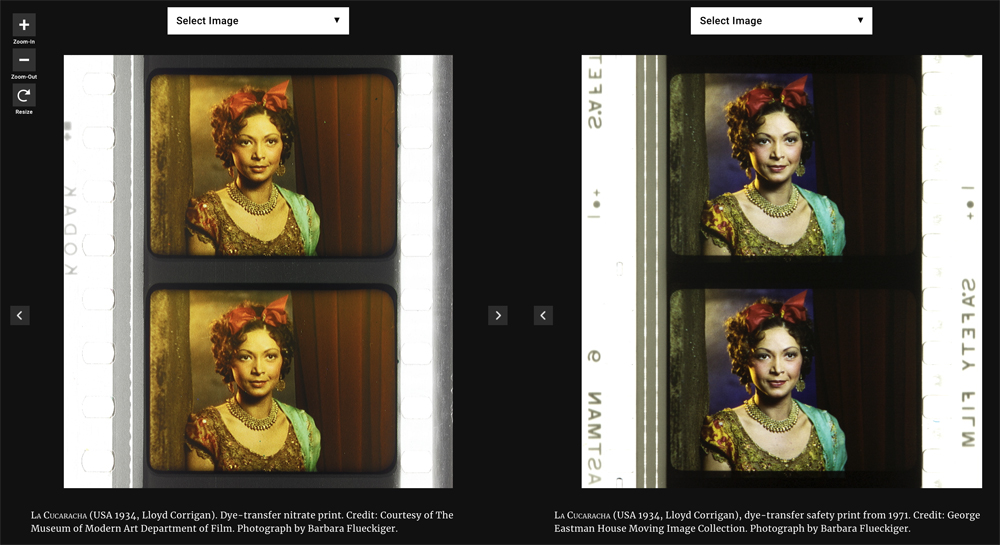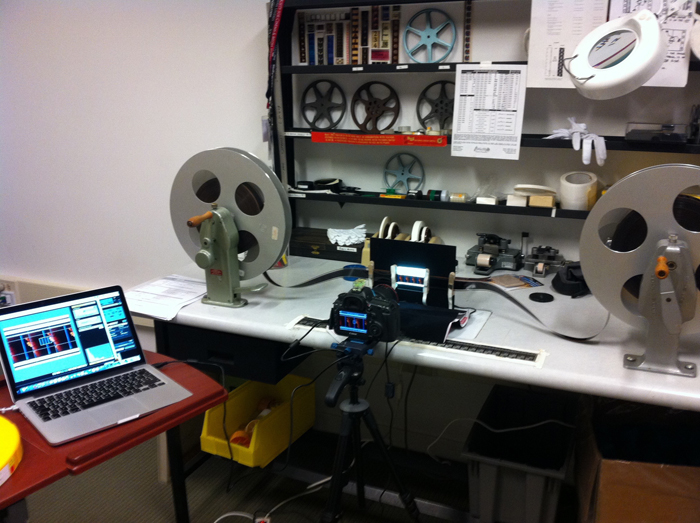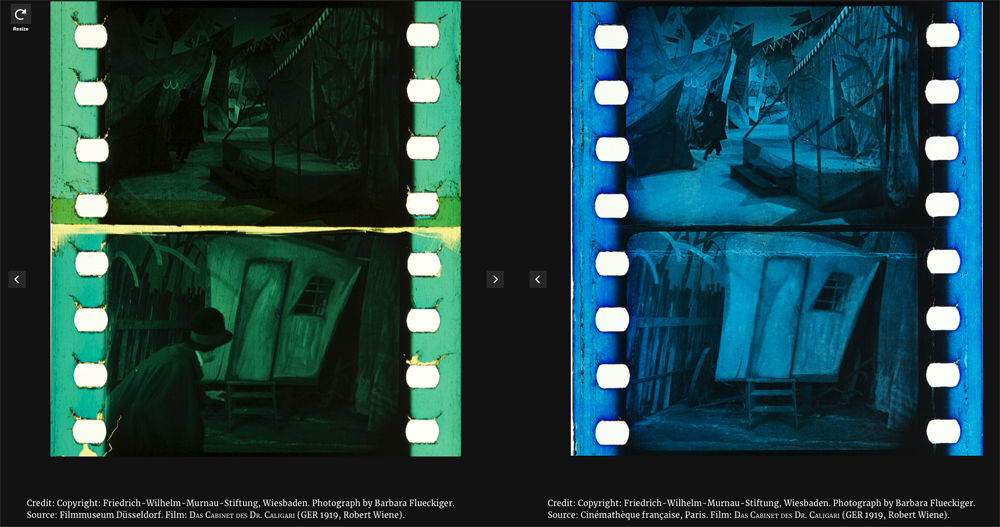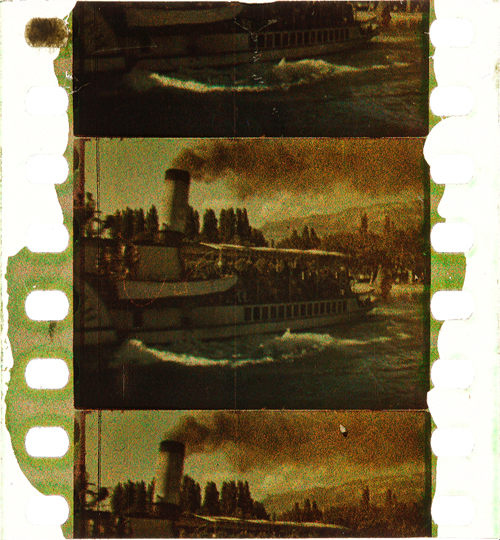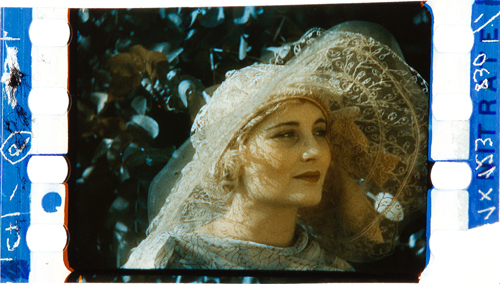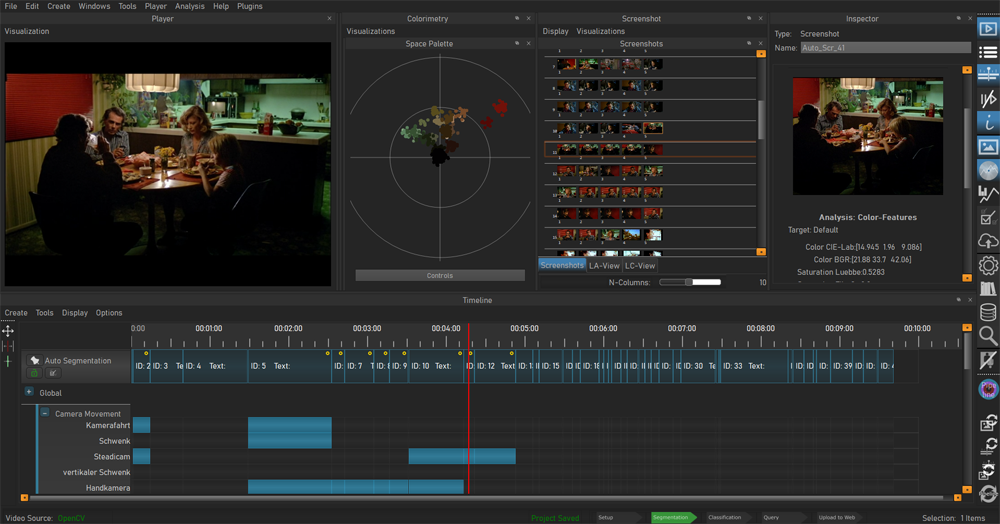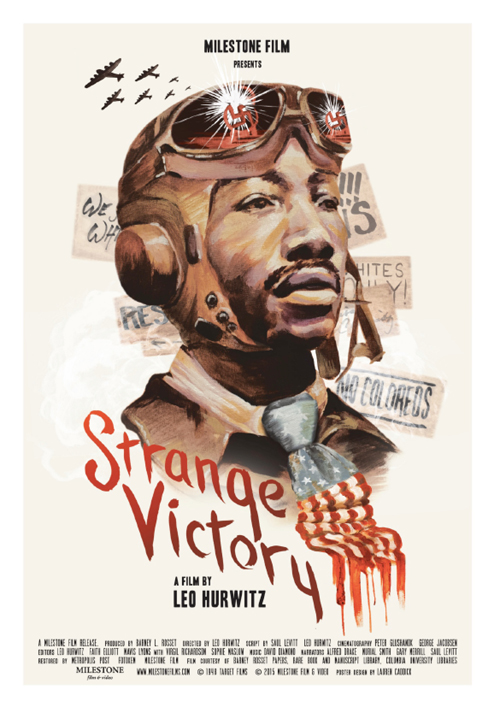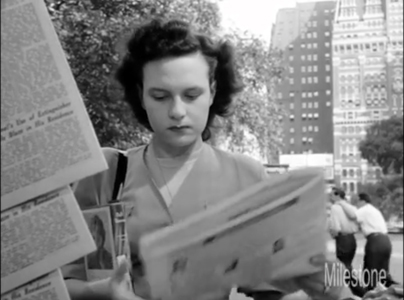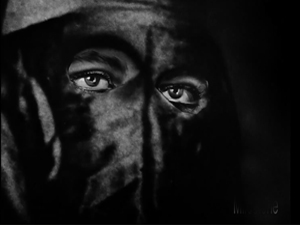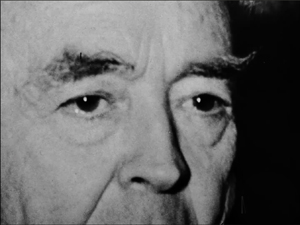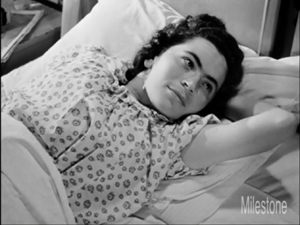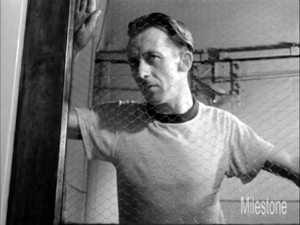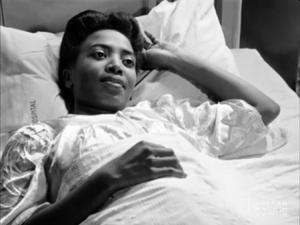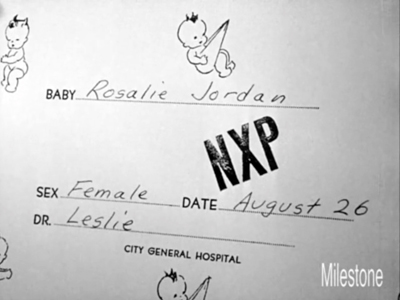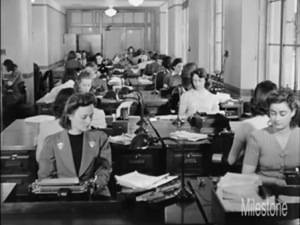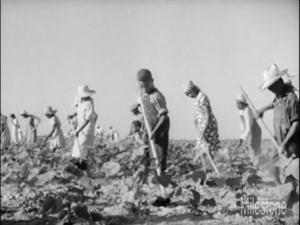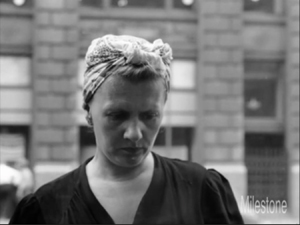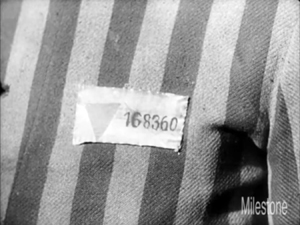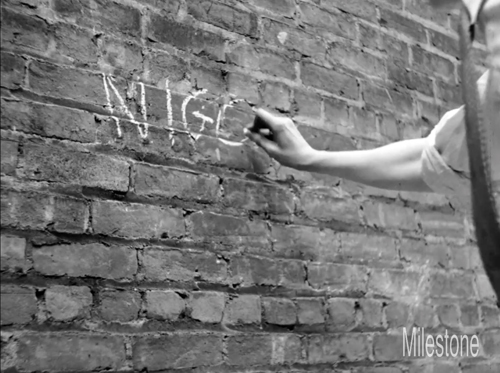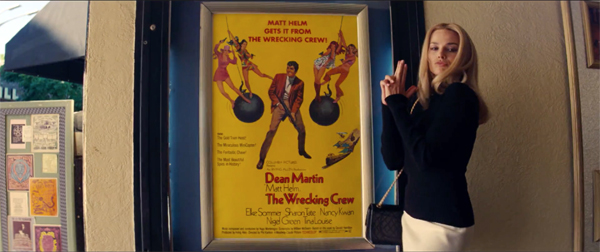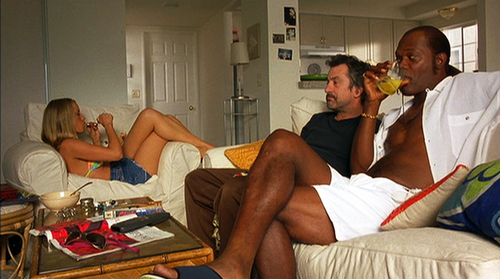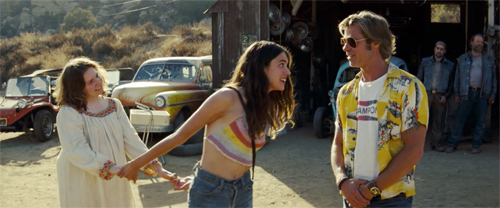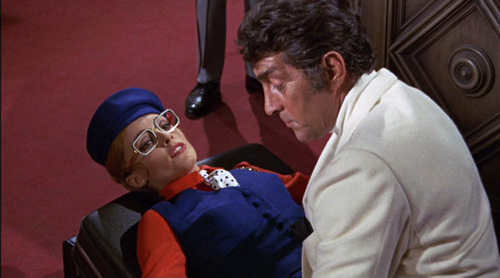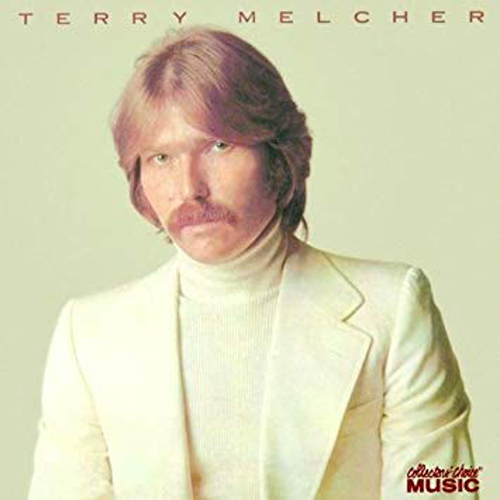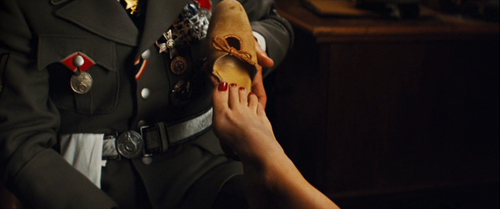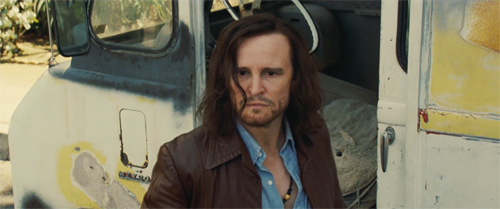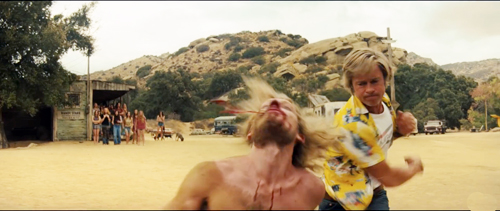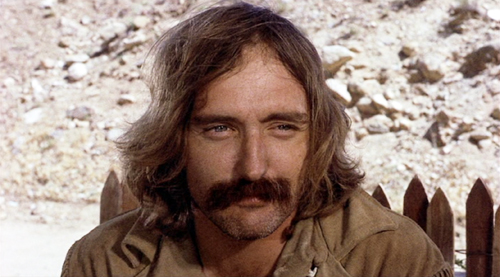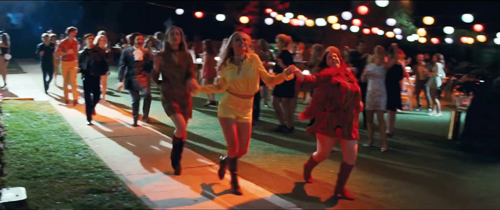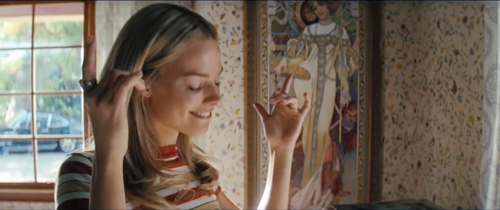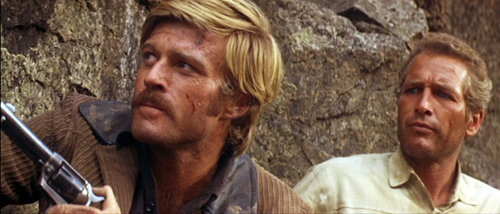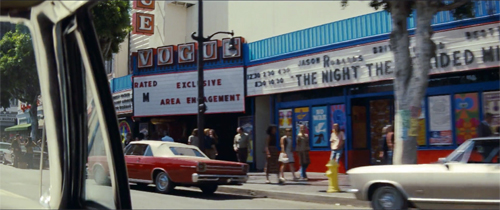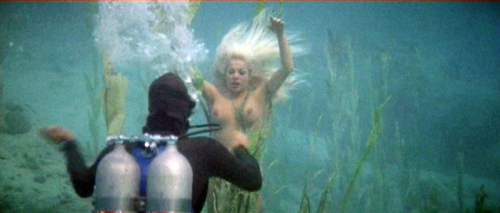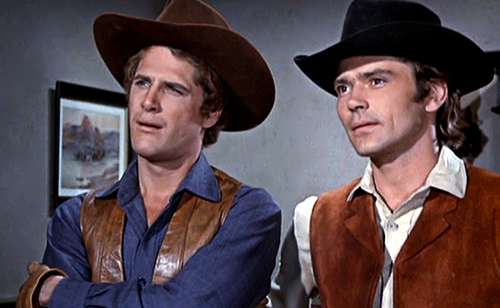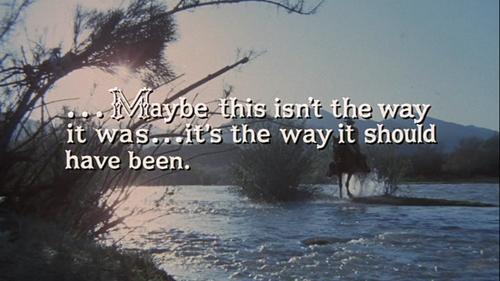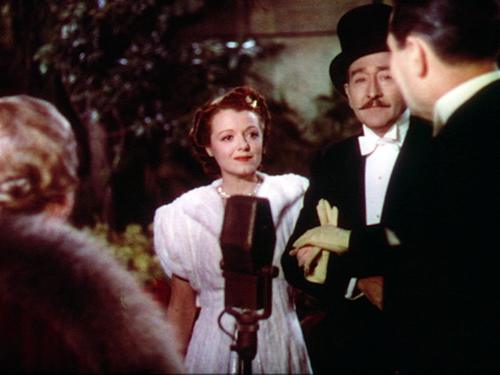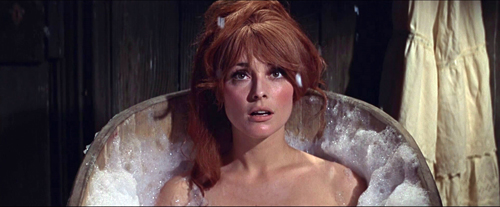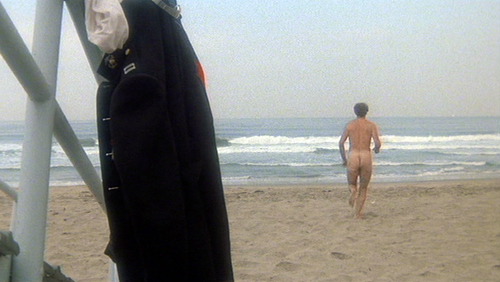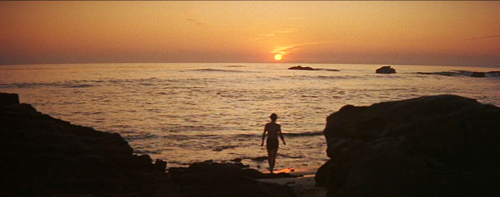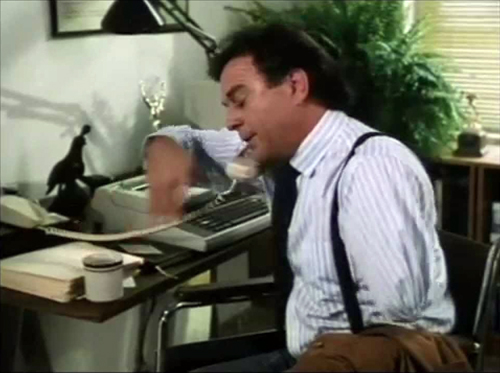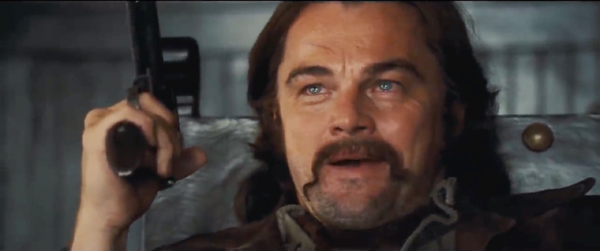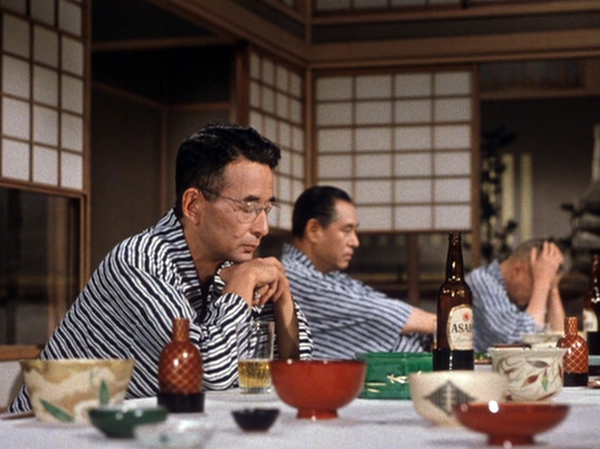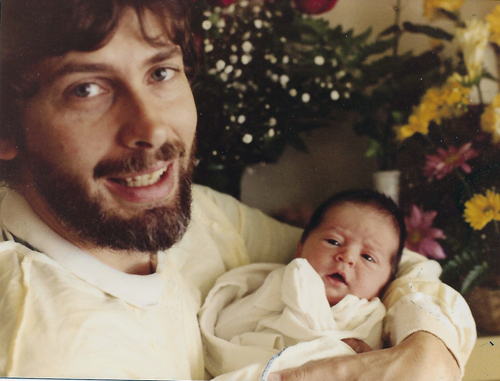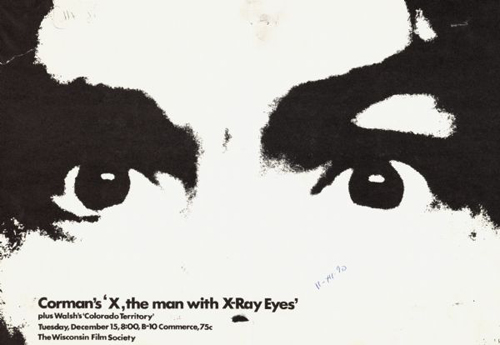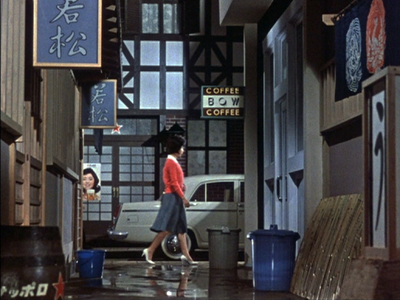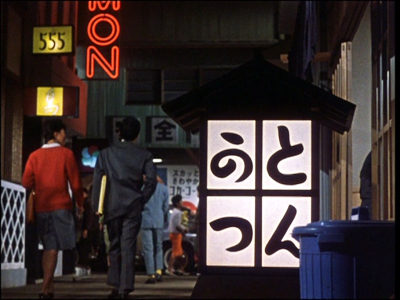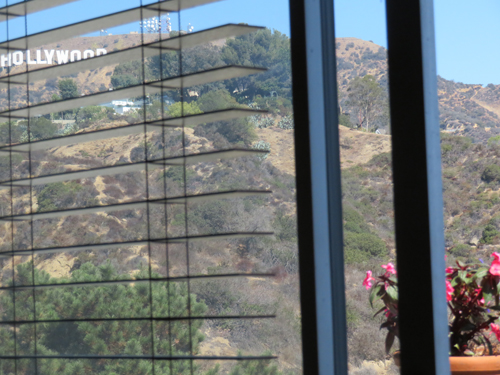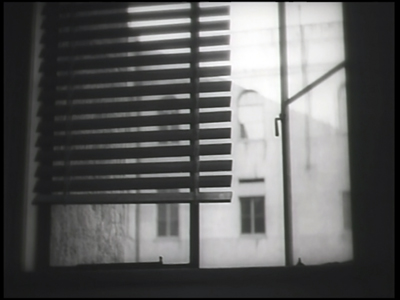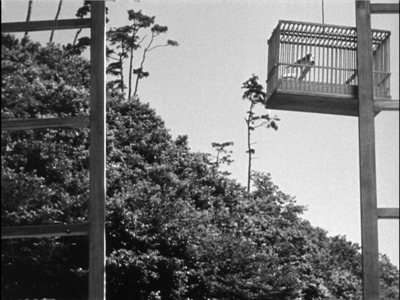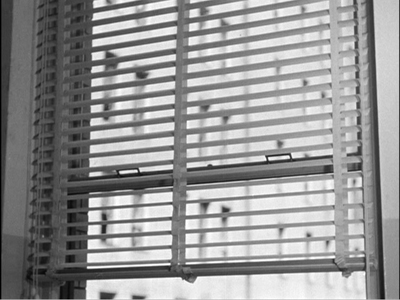Archive for the 'Readers’ Favorite Entries' Category
Historical film colors: A guest entry from Barbara Flueckiger
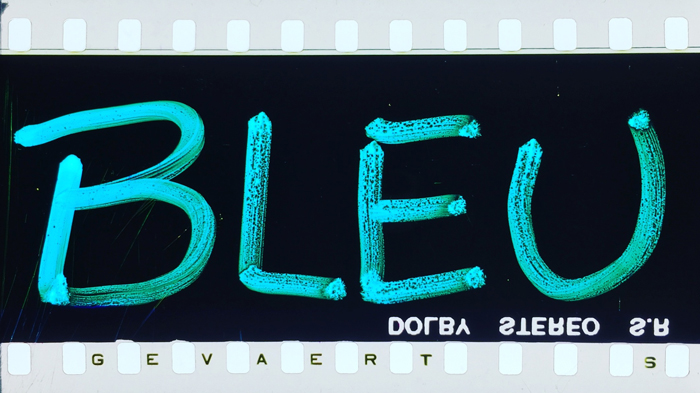
Trois couleurs: Bleu (France/Poland/Switzerland 1993, Krzysztof Kieślowski). Credit: Library of Congress. Photograph of the Agfa Gevaert safety print by Barbara Flueckiger.
Kristin here:
To the general film-going public, old films are in black-and-white. They may be vaguely aware that before The Wizard of Oz and Gone with the Wind, color film was invented.
The history of film color, however, is vastly more complicated than that. Prof. Barbara Flueckiger, of the University of Zurich, has devoted much of her career to studying that history. With Eva Hielscher and Nadine Wieylisbach, she co-edited the 2020 collection, Color Mania: The Material of Color in Photography and Film (Zurich: Eds. Lars Müller/ Fotomuseum Winterthur). Barbara has also spent the past decade leading a team who have created a recently inaugurated and invaluable website that acts as a boundless resource for information on color processes.
We are delighted that Barbara has accepted our invitation to write a guest blog entry for us. She describes the website and gives a succinct outline of the history of film color, loaded with beautiful illustrative frames. Most of these were taken from original archival prints that reveal how seldom–especially in this age of digital home video–we see color films as they looked when they were released.
Barbara Flueckiger
From their earliest days, films were colored. During the first three decades, most color imagery was obtained by applying dyes to black and white prints, either by hand, through stencils, or as tinting and toning of the filmstrips. From the beginning, however, many ideas emerged to capture colors directly on film as so-called mimetic colors. That could be done either by optical and mechanical means, such as colored rotary filters, or by chemical interventions, often in combination with optical configurations of cameras. Several hundred analog color processes and film stocks were invented in the first 100 years of film history. Many of them were never successful commercially.
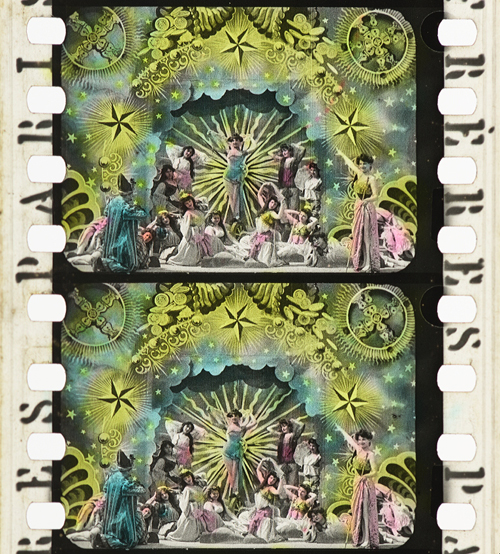
Ali Baba et les quarante voleurs (France 1902, Ferdinand Zecca). Credit: BFI National Archive. Photograph of the stencil-colored nitrate print by Olivia Kristina Stutz.
This history is largely unknown to the general audience as well as to many film scholars and historians.
To close this gap in our knowledge, in 2011 I started to develop the Timeline of Historical Film Colors, a comprehensive web resource. I wanted to document the development of film colors from their prehistory in still photography in the 19th century to the latest developments in the analog domain. As of 2021, the platform contains hundreds of primary and secondary sources, patents, links, selected analyses, physical measurements and downloads, as well as more than 23,000 photographs of historical film prints and negatives. These items provide film historians, researchers, archivists, curators, film restorers and students easy access to a vast array of information. A tagging system connects the entries, galleries, photos and quotes to an underlying thesaurus containing certain topics, persons, aesthetic concepts, technologies, archives, genres, persons or companies. A comparison function allows side-by-side inspection of different prints of the same film.
Why film color?
High-resolution photographs displayed in galleries are a central part of the Timeline of Historical Film Colors. Early on I developed a method to photographically capture and document historical film materials in a standardized way. It uses a modular and calibrated camera set-up based on a DSLR camera with a macro lens and remote control from the computer to adjust all the parameters. It is crucial to show the full range of color processes in an aesthetically pleasing way, one that aims at recreating the visual impression on the bench, including the edge information and color distribution in the perforation area. These elements are vital for the identification of film stocks and the genealogy of prints.
These photos allow researchers and students to examine individual historical prints, since they often have to work with less-than-ideal digitizations on DVDs and Blu-rays that are just a faint echo of the historical source material. In recent years this photographic method has been adopted by my teams in the current research projects. Some archives, such as the Academy Film Archive, have started to use the method, and the BFI National Archive and the George Eastman Museum plan to do so soon.
During the last years my teams and I visited many archives in Europe, the US and Japan to take these photographs, such as the Harvard Film Archive, EYE Filmmuseum Amsterdam, National Film Archive Prague, Deutsche Kinemathek Berlin, the Academy Film Archive, the Library of Congress, George Eastman Museum, the BFI National Archive, Cinémathèque française Paris, the UCLA Film & Television Archive, Bundesarchiv Filmarchiv Berlin, Museum of Modern Art, DFF Deutsches Filminstitut & Filmmuseum Frankfurt, the National Film Archive of Japan and others.
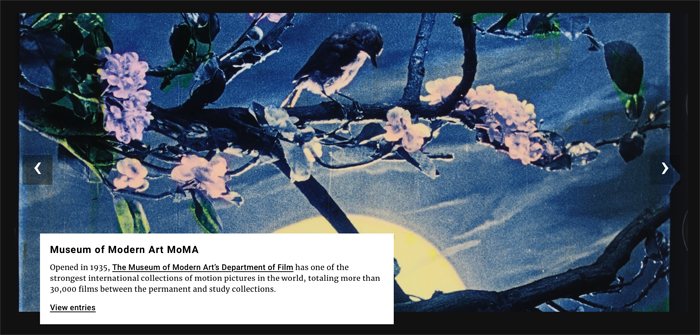
On the Timeline of Historical Film Colors each contributing archive is represented with a header slide that gives access to the film elements from their collection.
The lost colors of film history
Most films produced before the mid-1930s have been passed on in black-and-white prints. It was not until the famous FIAF conference in Brighton 1978 that the colors of the first decades of film history began to attract some attention from insider circles focusing on silent film.
To this day, the lack of awareness of film’s colorful past has persisted. Early applied colors such as tinting, toning, hand-coloring, and stencil-coloring are ephemeral by nature, since each exhibition print was dyed separately, in a variety of shades and hues. Moreover, these prints were produced with highly flammable nitrate cellulose as a base. Many deadly cinema fires in the early decades of the 20th century demonstrated the dangers of nitrate stock. Therefore, many original colored film prints have been hidden in cans sitting on the shelves in archives’ nitrate vaults. These facilities are fitted with special safety measures such as break-off walls and earth dams.
Eventually in the 1950s safety celluloid film stocks replaced nitrate. From that point on, new prints of colored early films were made on safety stock from the black-and-white camera negatives, intermediate negatives, or positive distribution prints. When colored distribution prints were used, the new copies were usually made only in black-and-white.
In the early 1980s a second threat to the history of colors in film became apparent. Martin Scorsese was among the prominent filmmakers and scholars who rang the alarm bell over the fading of so-called chromogenic stocks produced from the late 1930s to the 1980s. Due to the physical decay of mainly the cyan dye in these film stocks, original prints become nearly monochromatic, retaining mainly colors in the magenta to red spectrum. To this day, dye fading has remained one of the most pervasive problems for the search of authentic film colors.
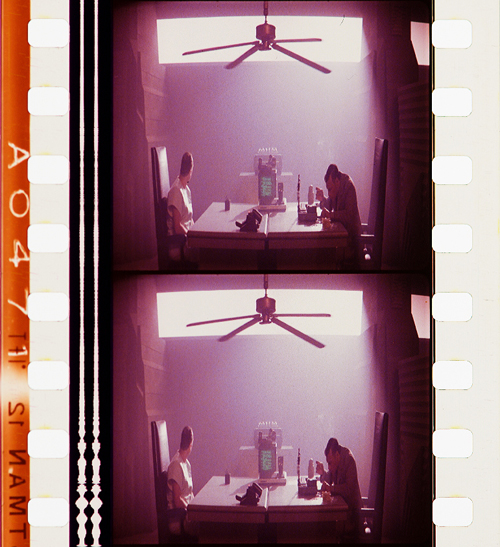
Color fading. Blade Runner (USA 1982, Ridley Scott). Credit: Library of Congress. Photograph of the Eastman Color Print Film by Joëlle Kost.
Applied colors
During the first three decades, so-called applied colors dominated. Historians estimate that about 80% of film prints were colored by tinting, toning, or hand- and stencil-coloring.
Tinting means submerging black-and-white film positives into dye baths, so that the prints’ gelatin emulsion acquired a more or less uniform, mostly monochrome color. Tinting can be identified by the inspection of the perforation area that is also uniformly colored. Toning, on the other hand, is a complementary process whereby the silver image is replaced by colored metallic pigments (metallic toning) or dyes (mordant or dye toning). In contrast to tinting, toning leaves the perforation area mostly colorless.
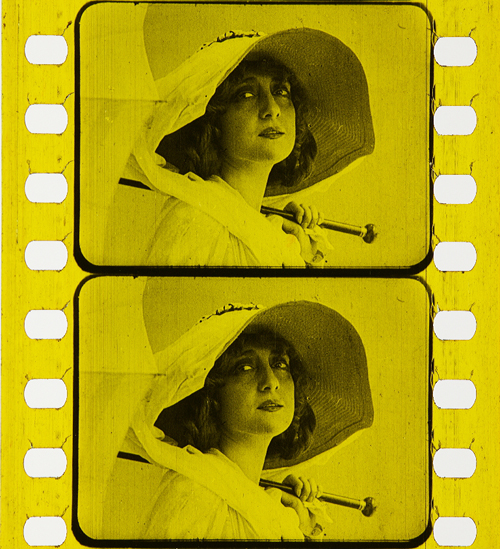
Tinting. Malombra (ITA 1917, Carmine Gallone). Credit: Cineteca di Bologna. Photograph of the tinted and toned nitrate print by Barbara Flueckiger.
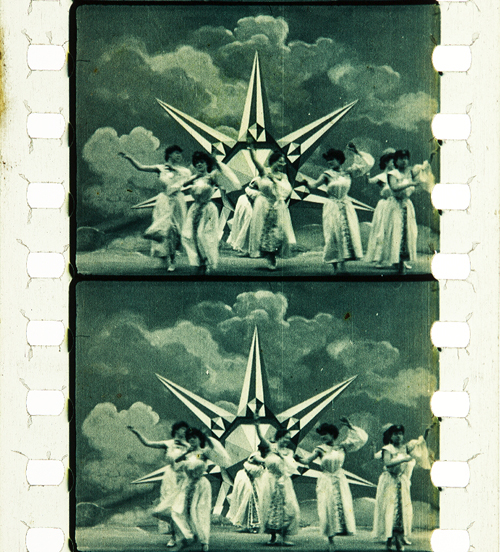
Toning. Voyage autour d’une étoile (France 1906, Gaston Velle). Credit: Cineteca di Bologna. Photograph of the toned nitrate print by Barbara Flueckiger.
For these coloring processes the individual prints had to be cut into segments that were then dyed in batches and reassembled into the final distribution print. As a result, individual prints can vary considerably in their color schemes.
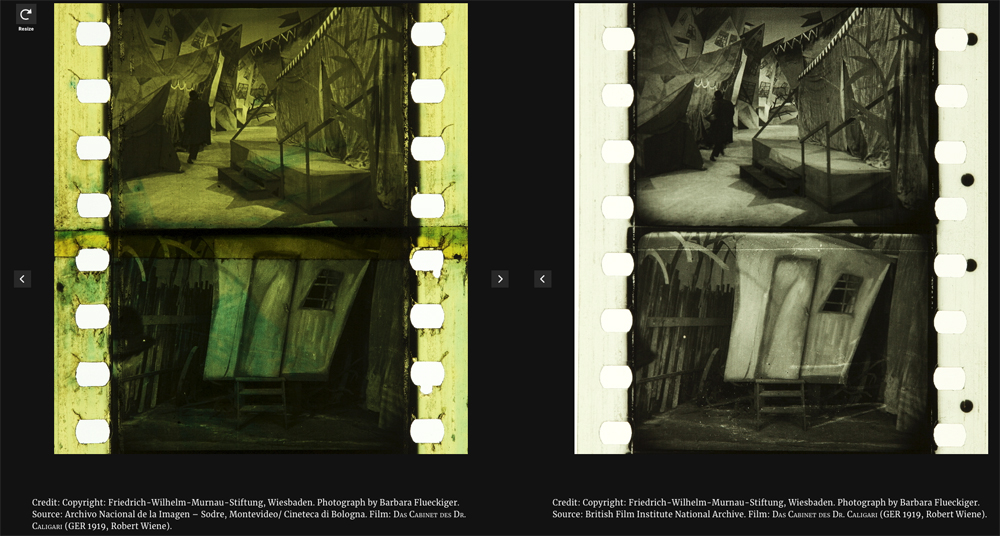
Comparison of four differently tinted and toned distribution prints of Das Cabinet des Dr. Caligari (Germany 1919, Robert Wiene). Copyright: Friedrich Wilhelm Murnau Foundation. Photographs by Barbara Flueckiger.
Whether tinting and toning schemes vary due to cultural norms and tastes has remained a topic of debate. To a high degree it is also uncertain who made the decisions about the coloring, except for cases where scripts, production notes, or film negatives indicate the attribution of colors. In addition to colored prints there were so-called copyright books that show the color scheme by single frames attached to the pages of the booklets, deposited at the Library of Congress by distributor George Kleine. Subtle shades emerged that often make it difficult to distinguish between the two, because the black silver image gives way to nuanced interactions with the tinting dyes in middle tones.
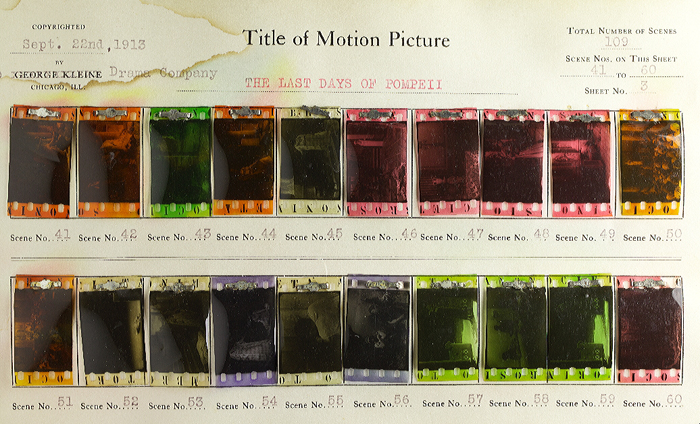
Copyright book from George Kleine: Gli ultimi giorni di Pompei (Italy 1913, Eleuterio Rodolfi). Credit: Library of Congress. Photograph Barbara Flueckiger.
In some cases, combining tinting and toning allowed for two colors to appear within a single image.
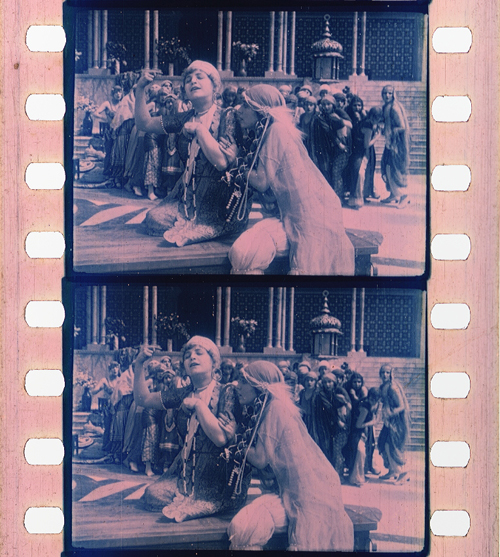
Tinting and toning combined. Sumurun (Germany 1920, Ernst Lubitsch). Credit: Bundesarchiv-Filmarchiv. Photograph of the tinted and toned nitrate print by Olivia Kristina Stutz.
The range and variety are even greater in the case of hand and stencil coloring. These techniques generally required the application of up to six dyes on each individual frame, either by hand through tiny brushes or by cut-out stencils. These laborious processes were demanding, given the small image area and the huge number of frames, generally 16 to 18 per second of running time. Hand-colored films show an uneven application of dyes with soft transitions between individual colors. For stencil coloring, each dye necessitated a separate, colorless print from which the stencils were cut out by needles or metallic styluses. As a result, shapes appear more or less sharp-edged. It was a mechanized version of hand coloring that allowed the coloring of feature-length films and higher numbers of distribution prints. Over the years, improved techniques were introduced to transfer the shapes from projected magnifications onto the film prints with the help of pantographs.
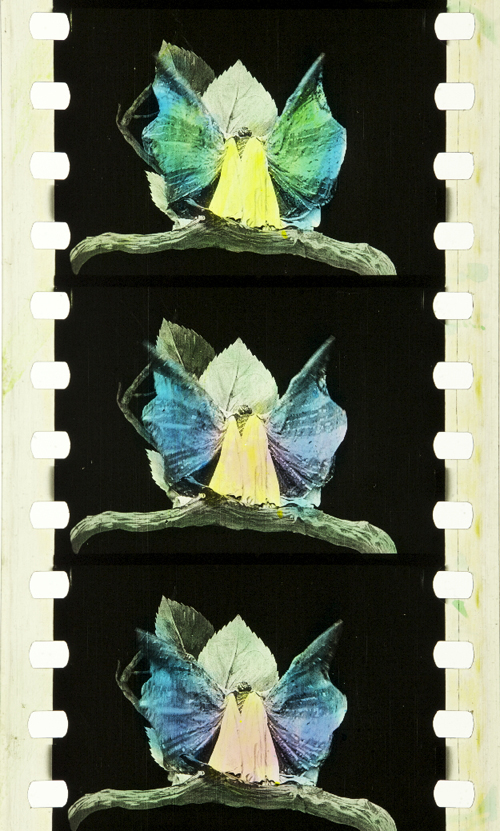
Hand coloring: Métamorphoses du papillon (France 1904, Gaston Velle). Credit: Library of Congress. Photograph of the hand-colored nitrate print by Barbara Flueckiger.
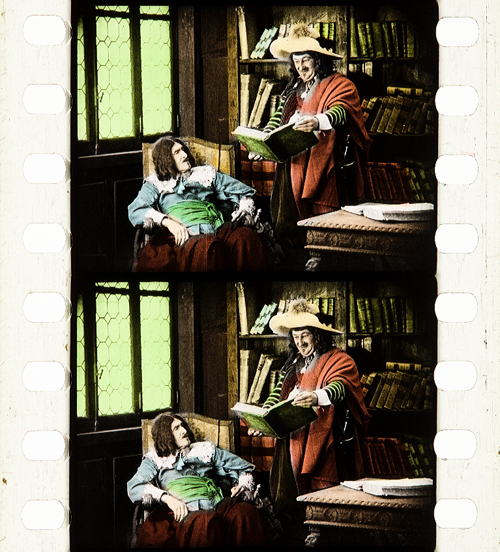
Stencil coloring. Cyrano de Bergerac (Italy/France 1923, Augusto Genina). Credit: EYE Filmmuseum Amsterdam. Photograph of the tinted, toned and stencil colored nitrate film by Barbara Flueckiger.
Needless to say, stencil and hand coloring were reserved for more ambitious or luxurious films. However, they also allowed for the creation of a higher reality effect in documentaries, travelogues, or fashion films by anticipating the development of mimetic colors. Exotic places, ethnicities, or historical settings were among the prevailing topics of stencil-colored films.

Documentary. La mangouste ou rat des pharaons (France 1914). Credit: Cineteca di Bologna. Photograph of the stencil-colored nitrate print by Noemi Daugaard.
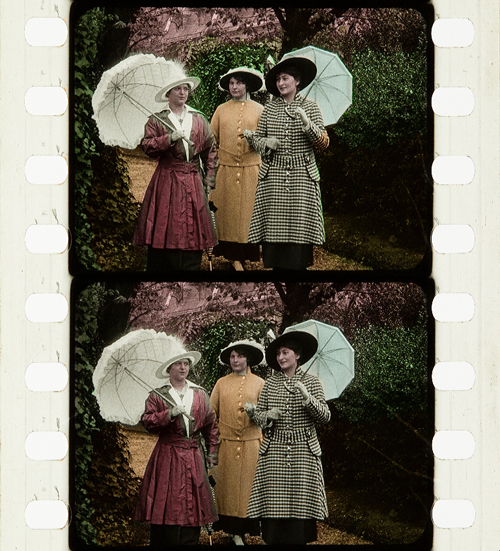
Fashion film. Modeflitsen (France 1918). Credit: EYE Filmmuseum Amsterdam. Photograph of the stencil-colored nitrate print by Bregt Lameris.
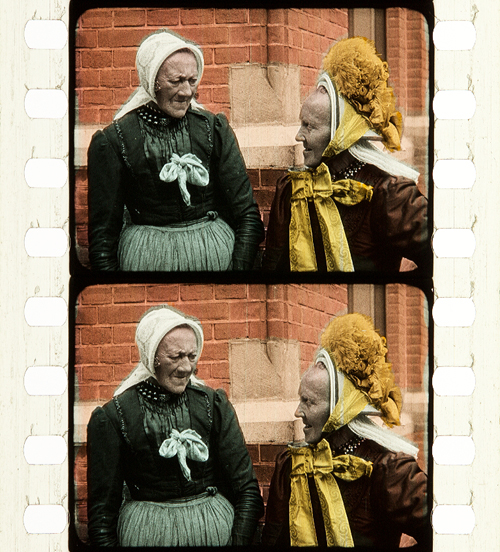
Travelogue. Coiffures et types de Hollande (France 1910, Alfred Machin). Credit: Cineteca di Bologna. Photograph of the stencil-colored nitrate film by Barbara Flueckiger.
In fact, the richness and scope of stencil-colored films can be fascinating to the modern viewer. That holds true for both the bolder color in the first decade of the 20th century or the more nuanced pastel shades that became increasingly prevalent in the 1920s.
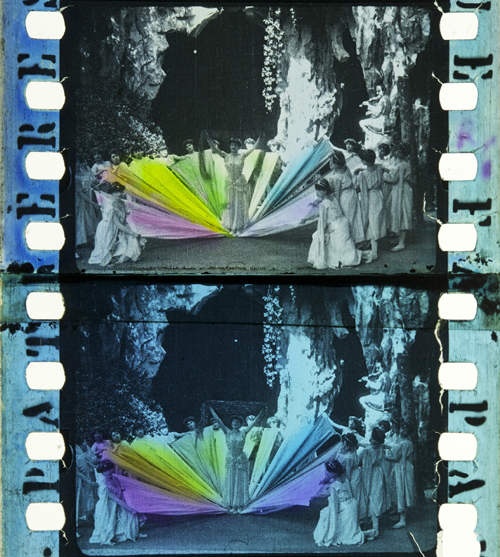
Bold colors in early film. L’Amour d’esclave (France 1907, Albert Capellani). Credit: Library of Congress. Photograph of the stencil colored nitrate film by Barbara Flueckiger.
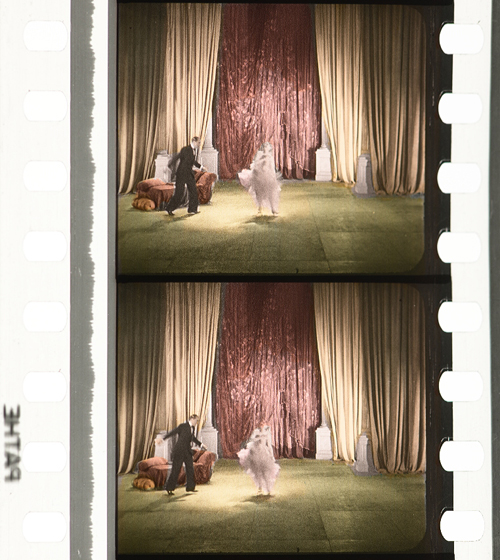
Subtle pastel shades in the 1930s. Elstree Calling (Great Britain 1930, André Charlot; Jack Hubert; Paul Murray; Alfred Hitchcock ). Credit: BFI National Archive. Photograph of the stencil colored nitrate print by Olivia Kristina Stutz.
A special case of applied colors is the Handschiegl process, a printing process developed by Max Handschiegl and Alvin Wyckoff, often used in Cecil B. DeMille’s films, especially for title cards. It produces highly detailed and precise colors with stunning effects.
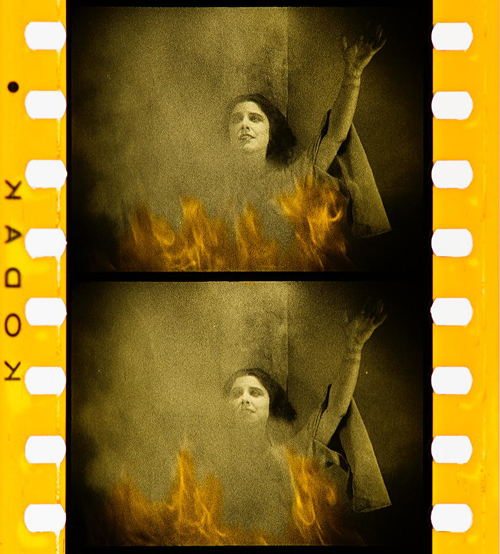
Handschiegl. Joan the Woman (USA 1916, Cecil B. DeMille). Credit: George Eastman Museum. Photograph of the tinted, toned and Handschiegl nitrate print by Olivia Kristina Stutz.
Mimetic colors
Already in France in the 1860s, Charles Cros and Louis Ducos du Hauron separately wrote descriptions of many of the principles for achieving mimetic colors in still photography. As it turned out, however, it was a much more demanding task to develop solutions for moving pictures. Some of the problems related to the high throughput during projection of 16 or more single frames per second. Other problems resulted from much higher requirements for image size on the big cinema screen, where resolution and registration were paramount. Due to the rapid succession of frames necessary for the illusion of movement, minute deviations occurring between frames created disturbing amounts of flicker or color fringing. Contemporary commentators often labeled the result as “color bombardment” that caused “eye strain”.
To this day, mimetic colors combine two to four color components either in additive or subtractive admixtures. In the 19th century their development followed psychophysical insights into the human visual system by Thomas Young and Hermann von Helmholtz. They showed that color impressions are the result of physiological sensors in the human retina sensitive to three different spectral ranges of the visible light.
Additive colors
Additive admixtures operate with colored light where the sum of the three additive primaries red, green and blue results in white light. The earliest attempts to create colors on the screen by optical means employed additive principles by rotary filters in front of the camera and projector respectively. These included the three-color Turner Lee and the most successful additive two-color process Kinemacolor.
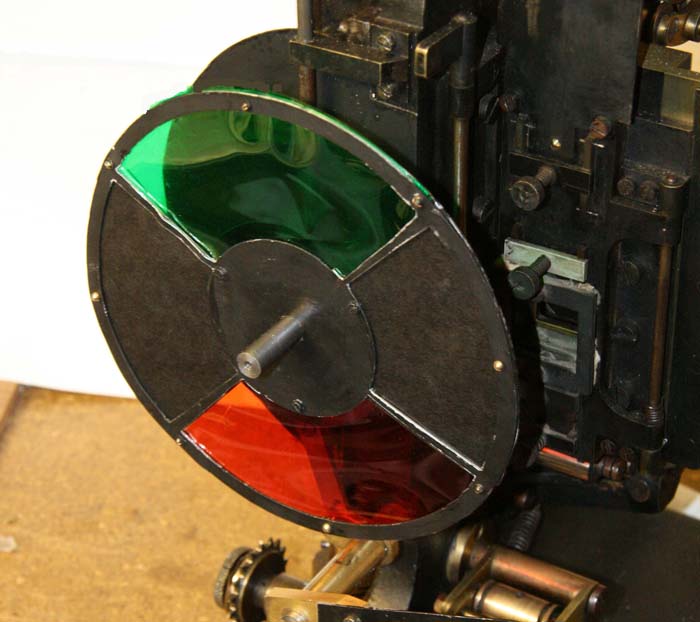
Rotary filter in front of the Kinemacolor projector used for David Cleveland’s and Brian Pritchard’s reconstruction. Credit: Brian Pritchard.
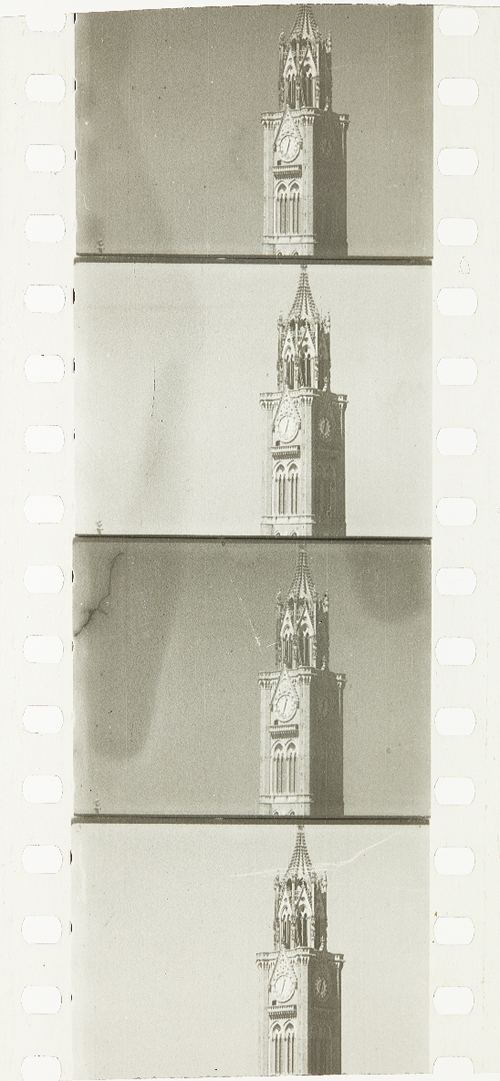
Kinemacolor positive from the Kodak Film Samples Collection. Credit: National Science and Media Museum Bradford. Photograph by Barbara Flueckiger in collaboration with Noemi Daugaard.
In Kinemacolor, rotary filters in red and green spinning in front of camera and projector recorded and transmitted the color information by temporal synthesis. The impression of color was created in the eyes of the spectators. Based on contemporary reports and digital reconstructions, the poor quality and limited color spectrum were readily apparent. Due to the temporal shift between the two successive frames with the red and green color separations, Kinemacolor and all processes operating by the same principle created color fringes and a headache-inducing amount of flicker.
Mroz Farbenfilm. Urlaubfarbenfilm F. Apfelthaler (AUT 1932, Friedrich Apfelthaler). Credit: Österreichisches Filmmuseum. Video and reconstruction by Giorgio Trumpy, David Pfluger and Martin Weiss.
Attempts with temporal synthesis were followed by additive processes that employed spatial synthesis by the application of beam splitters. In this configuration, up to three color records were taken through filters simultaneously to eliminate temporal parallax. But this approach introduced spatial parallax instead, and this arrangement could also create color fringes by poor registration. Gaumont’s Chronochrome process was certainly the most convincing attempt to combine three color separations with this principle.
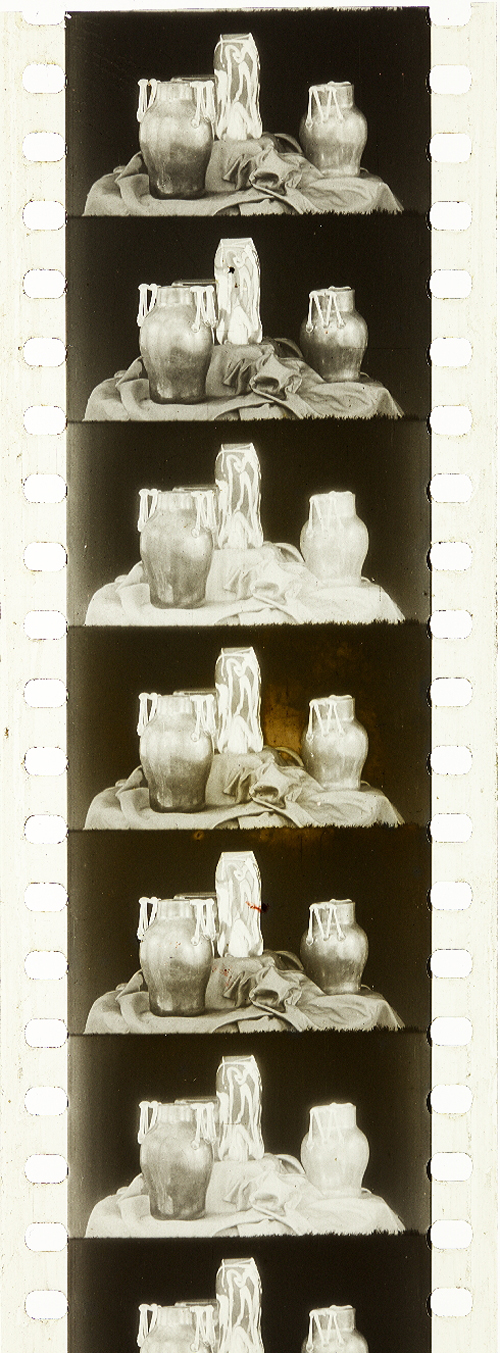
Gaumont Chronochrome positive from the Kodak Film Samples Collection. Credit: National Science and Media Museum Bradford. Photograph by Barbara Flueckiger in collaboration with Noemi Daugaard.
A third type operating with additive admixtures of light are the so-called screen processes. Additive colors are mixed, either by random, small-scale mosaic image elements or by organization into lines. Color impressions in these systems result from the fusion of the individual dots or lines into red, green and blue in visual perception. The effect resembles that of pointillist paintings where colors are divided into small dots.
Lenticular screen processes, by contrast, combine tiny lenses imprinted onto a black-and-white film strip with colored filters in front of the camera and projector.
Mosaic screens created by colored potato starch were popular in still photography with the Lumière brothers’ Autochromes, introduced in 1907 and widely used by professionals and advanced amateurs. The principle was later adopted in the Cinécolor process for color film but failed due to the uneven distribution of the starch particles. Among the line screen processes, Dufaycolor was the most successful one, widely used in documentaries and famously in Len Lye’s experimental films with direct animation painted directly onto the film strip and then captured and distributed on Dufaycolor film stock. Apparently, Lye was not convinced by the somewhat muted color palettes of the process.
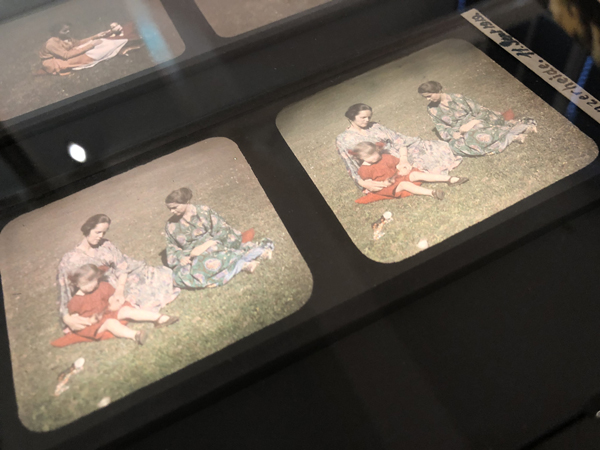
Stereoscopic Autochrome Lumière. Exhibition Color Mania – Materiality of Color in Photography and Film, Fotomuseum Winterthur, September 7 to November 24, 2019. Photo by Barbara Flueckiger.

Photomicrograph of Spicer-Dufay, early Dufaycolor (20x). Credit: Photomicrograph by Silvana Konermann.
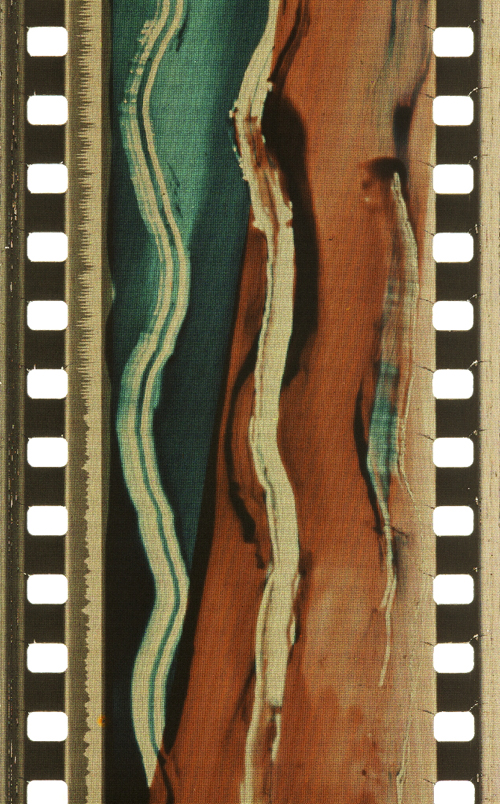
Dufaycolor. A Colour Box (Great Britain 1935, Len Lye). Credit: BFI. Photograph of the Dufaycolor di-acetate print by Barbara Flueckiger.
Lenticular films such as Kodacolor were also mostly used for home movies with the exception of Thomson color for Jacques Tati’s Jour de fête (France, 1949).
None of the additive principles proved to be successful for the long term. Many of them required special installations in the cinema, and most delivered poor results, most notably dim images.
Subtractive colors
Finally, subtractive admixtures became the norm. The three primaries cyan, yellow and magenta filtered the light, with black being the sum of these three subtractive colors. Two or three differently colored emulsion layers are attached to the film base, on one side or both sides of the film.
Most early two-color films were using double coated film stock. The earliest one was Kodachrome Two-color developed in 1915, presented in 1916 with the short film Concerning $1000, but mostly in use in the 1920s for fashion films, for the dance film The Flute of Krishna (USA 1926) by choreographer Martha Graham and for the experimental film [Kaleidoscope] by Loyd A. Jones. Kodachrome Two-color film was shot through a beam splitter and combined two emulsions in orange-red and bluish green on either side of the film carrier, with beige, brown and golden tones in the spectrum between the two color components.
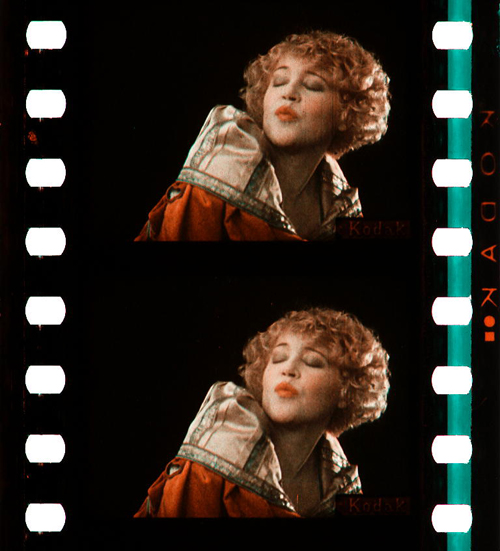
Kodachrome Two-color Test Shoot No. III (USA 1922, Anonymous). Credit: George Eastman Museum. Photograph of the Kodachrome two-color double coated stock by Olivia Kristina Stutz.
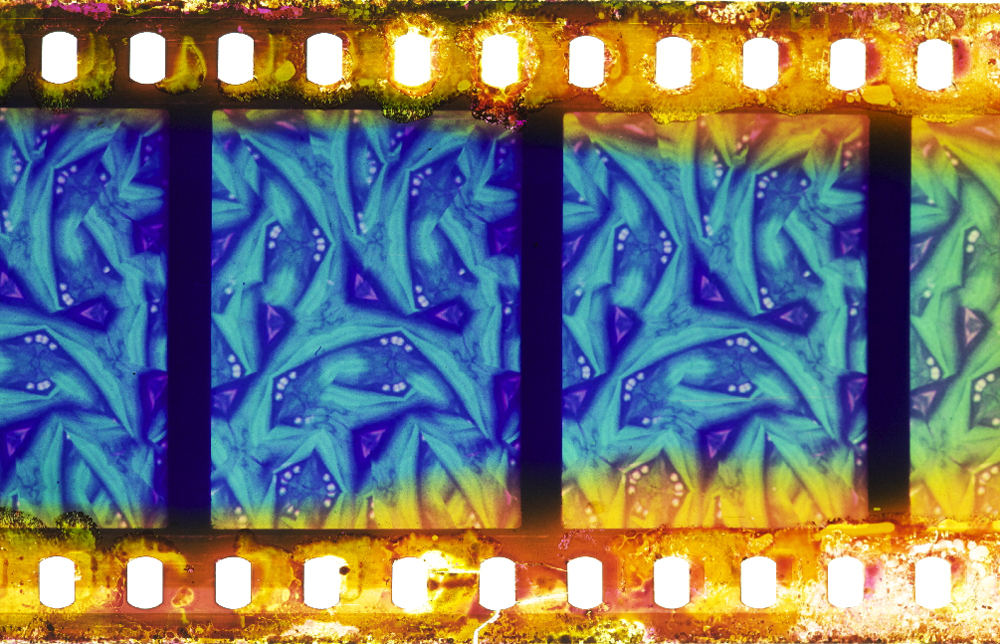
Kodachrome Two-color. [Kaleidoscope] (USA ca. 1927, Loyd A. Jones). Credit: George Eastman Museum. Photograph of the Kodachrome two-color double coated stock by Barbara Flueckiger.
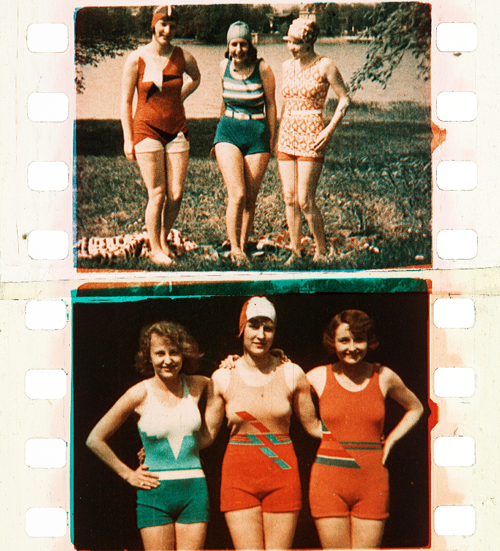
Sirius Farbenfilm. [Farbfilmversuche] (Germany 1920s or 1930, Ludwig Horst; Hans Horst). Credit: Deutsches Filminstitut DFF. Photograph of the Sirius color nitrate print by Barbara Flueckiger.
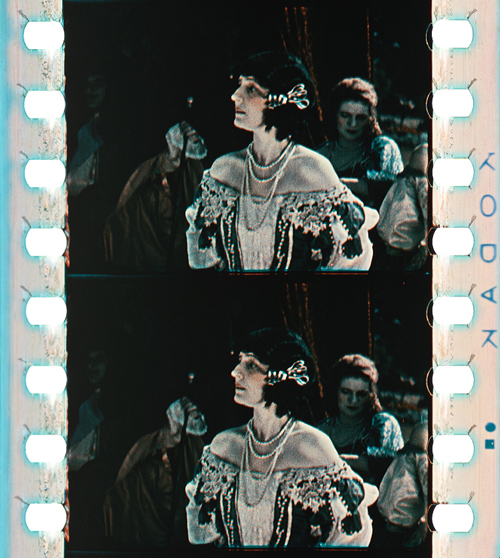
Prizma II. The Glorious Adventure (Great Britain 1922, J. Stuart Blackton). Credit: BFI National Archive. Photograph of the tinted and Prizma II nitrate print by Olivia Kristina Stutz.
In the 1930s subtractive processes turned to three colors, most famously with Technicolor No. IV and the subsequent Technicolor No. V, which was printed from chromogenic camera negatives. Founded in 1915, the Technicolor Company went through many failures and set-backs, with the exception of a short color rush in the late 1920s with the two-color dye-transfer process Technicolor No. III. Following the series Great Events with 12 short films produced by the Technicolor company to establish the process, mostly musicals and a few other genres exploited the two-color process during this short boom. But some of them are highly remarkable, with sophisticated camerawork by Technicolor’s own cinematographer Ray Rennahan, including the musical Whoopee! (USA 1930, Thornton Freeland) choreographed by Busby Berkeley, King of Jazz (USA 1930, John Murray Anderson, Pál Fejös), Doctor X (USA 1932, Michael Curtiz), and Mystery of the Wax Museum (USA 1933, Michael Curtiz).
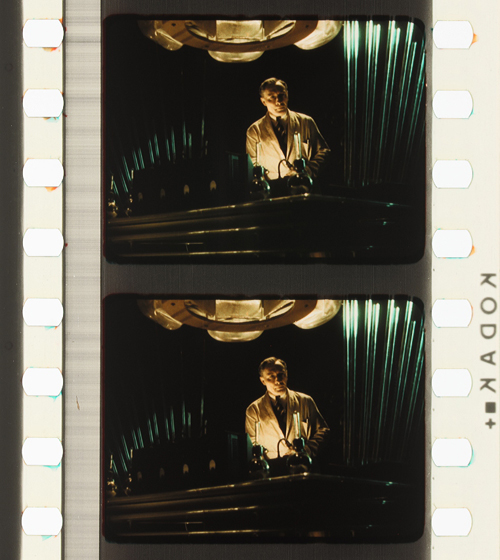
Technicolor No. III. Doctor X (USA 1932, Michael Curtiz). Credit: UCLA Film & Television Archive. Photograph of the Technicolor No. III dye-tranfer nitrate print by Barbara Flueckiger.
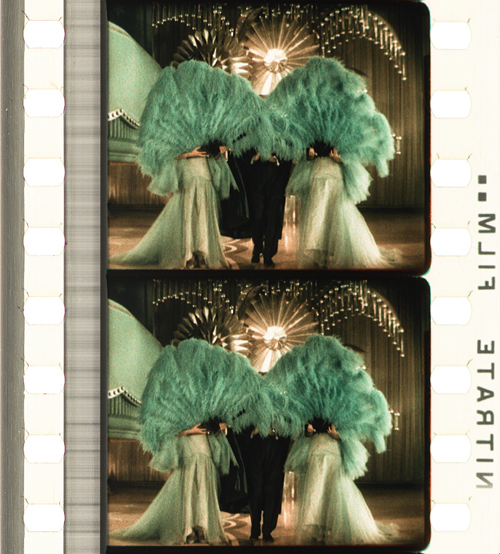
Technicolor No. III. King of Jazz (USA 1930, John Murray Anderson; Pál Fejös). Credit: Library of Congress. Photograph of the Technicolor No. III dye-tranfer nitrate print by Olivia Kristina Stutz.
While the technologies applied in Technicolor’s various processes changed considerably over the years, the beam splitter was one of the few constants. Both in Technicolor No. II and III, a beam splitter separated the two color records and captured them mirrored upside down on one black-and-white negative. The bulky and heavy Technicolor No. IV camera recorded the color separations on three black-and-white 35 mm negatives. From these three negatives matrices were produced as wash-off reliefs, ready for the dye-transfer of the three primaries onto the positive print. The result was a series of color images, along with the frame lines and the soundtrack as silver images.
For almost two decades Technicolor dominated the market for high-quality color films. Part of its success was due to a comprehensive package that included the camera, specialized cinematographers, and all the lab works executed exclusively in Technicolor’s own plants. One of the building blocks of Technicolor’s long-term dominance, however, was the so-called Color Advisory Service, famously led by color consultant Natalie M. Kalmus. She defined aesthetic guidelines for film productions shot with the process, informed by color norms related to concepts of “elevated taste,” located in a broader cultural context with references to the concept of “color consciousness.”
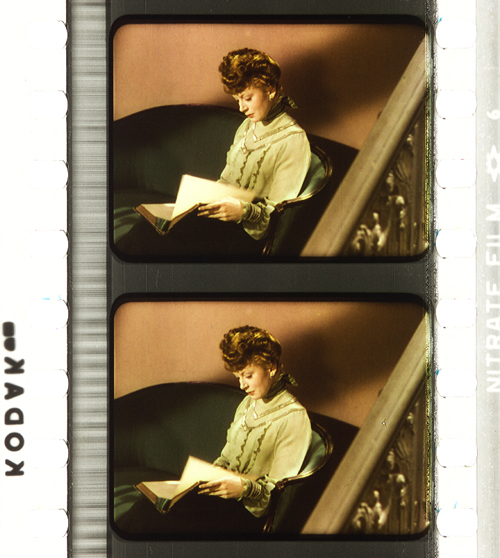
Technicolor No. IV. The Life and Death of Colonel Blimp (Great Britain 1943, Michael Powell; Emeric Pressburger). Credit: BFI. Photograph of the dye-transfer nitrate print by Barbara Flueckiger.
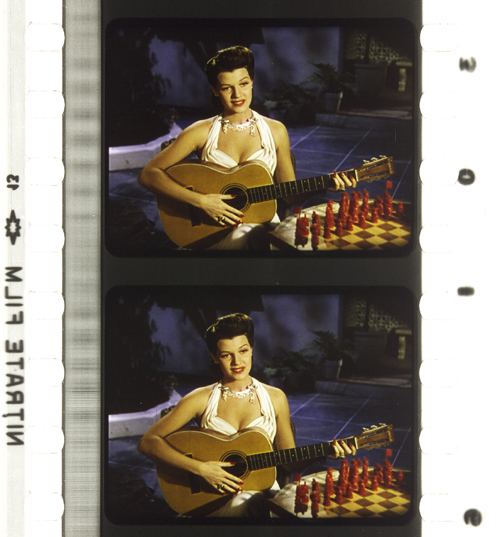
Technicolor No. IV. Blood and Sand (USA 1941, Rouben Mamoulian). Credit: BFI. Photograph of the dye-transfer nitrate print by Barbara Flueckiger.
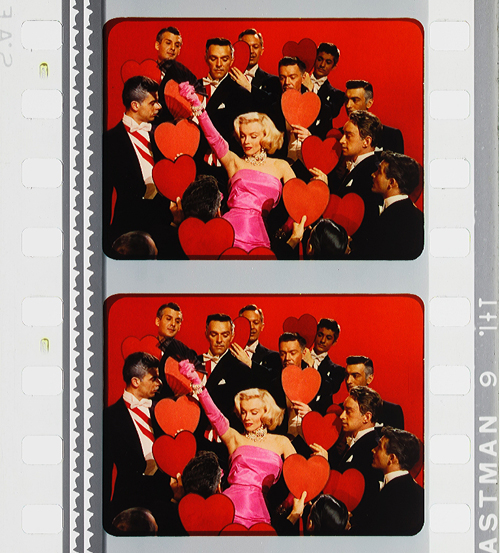
Technicolor No. IV. Gentlemen Prefer Blondes (USA 1953, Howard Hawks). Credit: Library of Congress. Photograph of the dye-transfer safety print by Barbara Flueckiger.
Despite all the efforts to control the color schemes, people often associate Technicolor with highly saturated, deep colors. On close inspection in our detailed analyses of color films, however, we have observed that many films adhere to the rules with mostly restrained color schemes and unsaturated backgrounds to guarantee optimal figure/ground separation. But there are also deviations from these self-imposed norms, surprisingly clashing hues even in films produced with Natalie M. Kalmus as color consultant.
Moreover, there is a great variability of different looks and color applications during the almost two decades. Individual color aesthetics were related to personal styles of cinematographers, directors or production companies, genres or changing preferences in fashion and design, and changing color compounds and recipes employed in the process. Technicolor’s idiosyncrasies – what we perceive as typical “Technicolor look” – are mostly due to the dye-transfer process itself. Pasty, dense colors in patchy structures create an almost opaque appearance on the screen, an effect somewhat like oil paint. When we work with the film elements on the bench in archives, we not only have to increase exposure considerably due to the density of the film stock, but we also notice the color layer’s almost sticky viscosity, often visible as a relief on the surface.
Compared to Technicolor, Gasparcolor produced much more saturated, brilliant and luminous colors. In fact, the process, developed in the early 1930s by Hungarian emigré Béla Gaspar in Germany, was possibly the most advanced and complex process at the time. In its principle–the silver dye-bleach process described by Raphaël E. Liesegang in the late 1890s – the silver acted as a catalyst for the local destruction of the dyes embedded in the three emulsion layers on the two sides of a reversal positive. It is thus a chromolytic reversal process. Due to the political circumstances during the Third Reich in Germany, Gaspar eventually had to flee.
Like Technicolor Gasparcolor required the recording of three color separations on black-and-white negatives. Since most of the Gasparcolor films were animations, these separations were captured in succession on adjacent film frames but could of course also have been shot through a beam splitter similar to Technicolor No. IV. In fact, only one documentary is widely known, Colour on the Thames (Great Britain, 1936), shot by Adrian Cornwell-Clyne. Among the films produced with Gasparcolor are famous avant-garde experimental films by Oskar Fischinger, Hans Fischinger, and Len Lye. Gasparcolor prints can easily be identified by the black perforation area and the colored soundtrack.
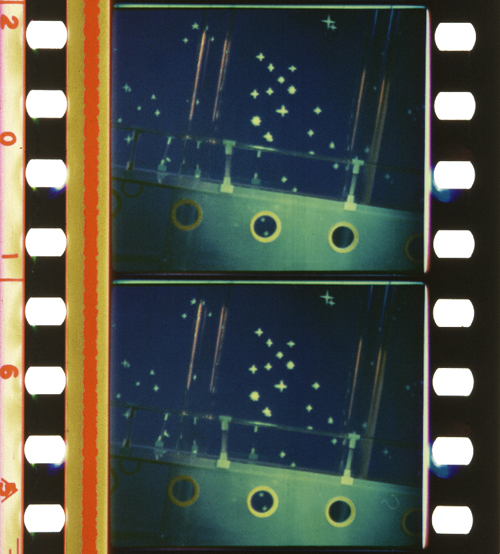
Gasparcolor. The Ship of the Ether (Netherlands 1934, George Pal). Credit: BFI National Archive. Photograph of the Gasparcolor nitrate print by Barbara Flueckiger.
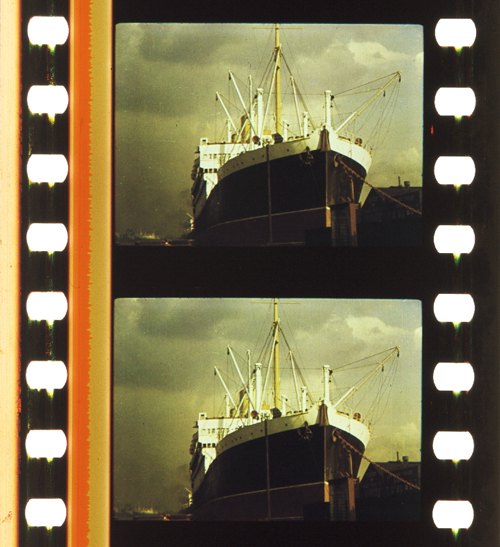
Gasparcolor. Colour on the Thames (Great Britain 1935, Adrian Klein). Credit: BFI National Film Archive. Photograph of the Gaspar color nitrate print by Barbara Flueckiger.
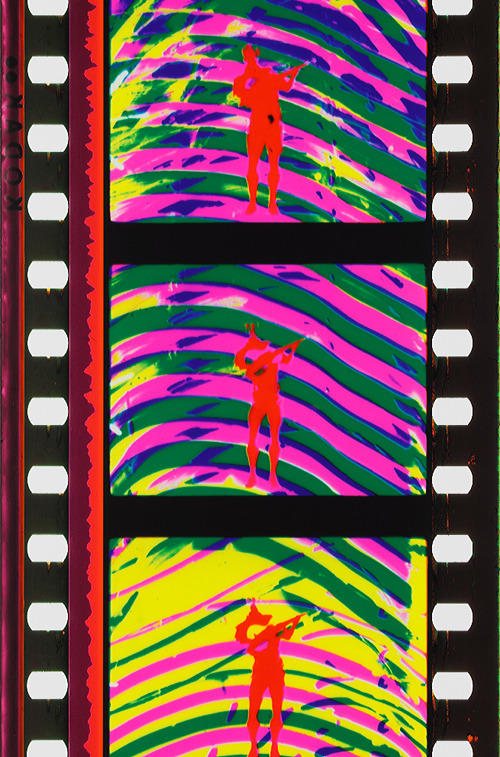
Gasparcolor. Rainbow Dance (Great Britain 1936, Len Lye). Credit: Museum of Modern Art. Photograph of the Gaspar color nitrate print by Barbara Flueckiger.
Both Technicolor and Gasparcolor prints stored in archives are in remarkably good shape, due to their stable colors. Ironically, chromogenic film stocks, the technical principle that ultimately won the competition and became the new standard, had the least stable dyes. Chromogenic means that the dyes need to be developed after exposure. Embedded in the emulsion of a single strip of film stock are three or more layers. These layers are sensitive to different spectra. All contain silver halides and the color-forming substances, so-called dye couplers that are subsequently developed into dyes. In a second stage the silver is bleached out and leaves the color information in the form of finely dispersed dye clouds in the three or more emulsion layers in cyan, magenta and yellow. The result is a highly translucent, glowing image whose fine-grain structure depends on the speed of the film stock. The slower the speed, the finer the grain.
In contrast to Technicolor the shooting of the chromogenic film could be done with normal cameras on one negative or camera reversal. Chromogenic films increasingly became the norm, starting with Agfa’s first negative-positive process Agfacolor. Emerging in the late 1930s, Agfacolor was promoted by German propaganda in a bid to counteract Technicolor’s dominance. Agfacolor had particularly soft colors in the pastel range with a typical, slightly darkened orange-tomato red. Difficulties in the blue range produced turquoise shades that become quite apparent in skies. Greens had a tendency to look brownish or blackened; shadows had a greenish tinge. Chromogenic multilayer film stocks were incredibly difficult to balance and to produce, requiring a high level of knowledge in physics and chemistry.
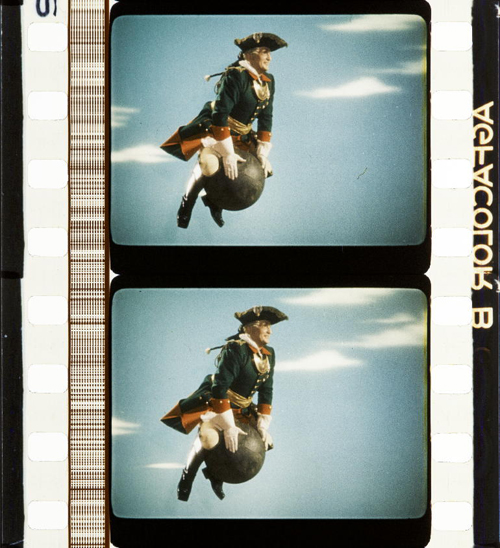
Agfacolor. Münchhausen (Germany 1943, Josef von Báky). Credit: Copyright Friedrich Wilhelm Murnau Foundation. Bundesarchiv Filmarchiv. Photograph of the Agfacolor safety print (acetate) by Barbara Flueckiger.
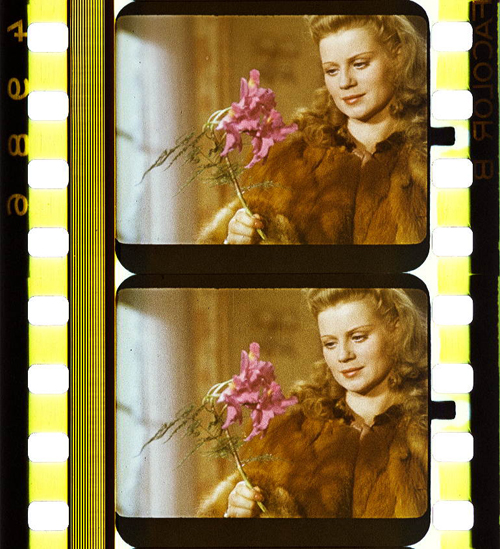
Agfacolor. Opfergang (Germany 1944, Veit Harlan). Credit: Copyright Friedrich Wilhelm Murnau Foundation. Filmmuseum Düsseldorf. Photograph of the Agfacolor Safety Print by Barbara Flueckiger.
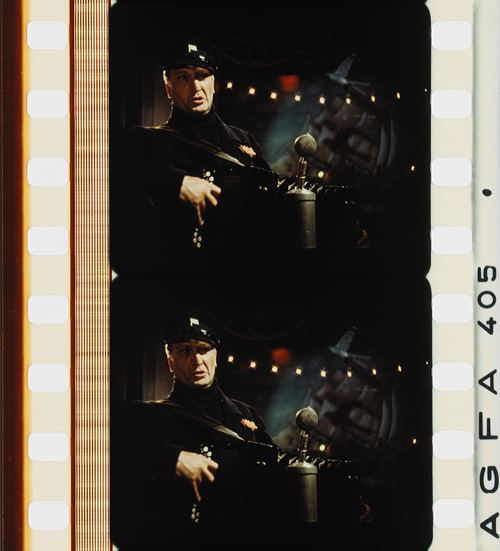
Agfacolor. Grosse Freiheit Nr. 7 (Germany 1944, Helmut Käutner). Credit: Copyright Friedrich Wilhelm Murnau Foundation. Bundesarchiv Filmarchiv. Photograph of the Agfacolor nitrate print by Michelle Beutler.
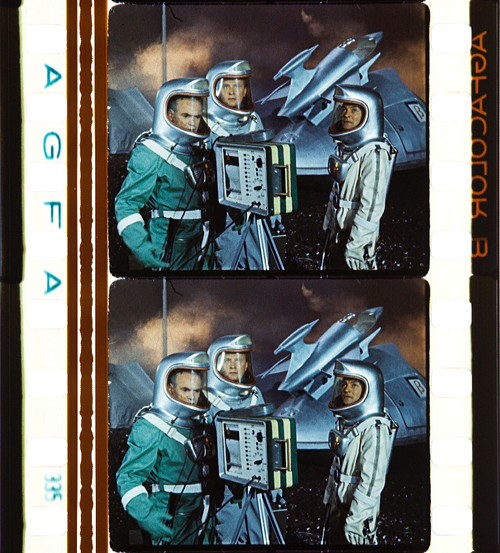
Agfacolor. Der schweigende Stern (German Democratic Republic 1960, Kurt Maetzig). Credit: Bundesarchiv Filmarchiv. Photograph of the Agfacolor safety print by Josephine Diecke.
After World War II ended, the Allies were able to exploit German color-film patents. The result was the appearance of Fujicolor, Eastman Color, and many derivatives, such as Ferraniacolor, Ansco Color, and Sovcolor. The worldwide adoption of color in film production soon followed.
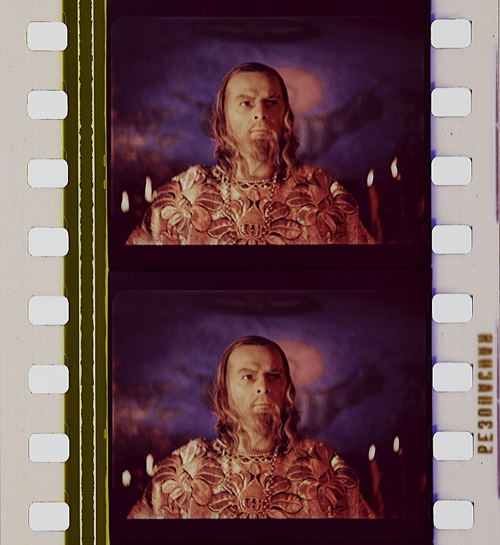
Sovcolor. Ivan the Terrible, Part II (Russia 1958, Sergei M. Eisenstein). Credit: Museum of Modern Art. Photograph of the Sovcolor safety print by Barbara Flueckiger. (The film was shot in the 1940s on captured Agfacolor stock, but the delay in the release of the film until 1958 meant that distribution prints were on Sovcolor stock.)
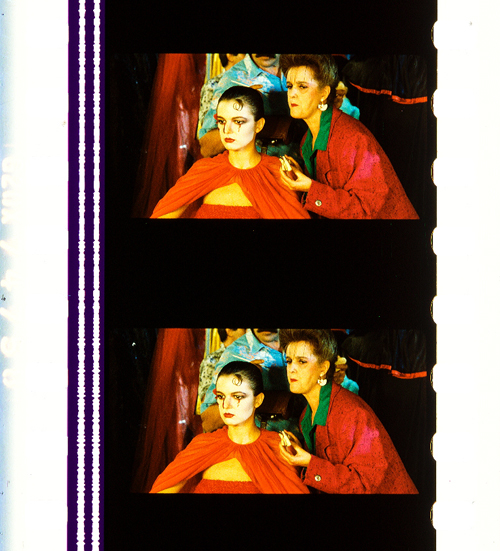
Fujicolor. Matador (Spain 1986, Pedro Almodóvar). Credit: Library of Congress. Photograph of the Fujicolor safety print by Barbara Flueckiger.
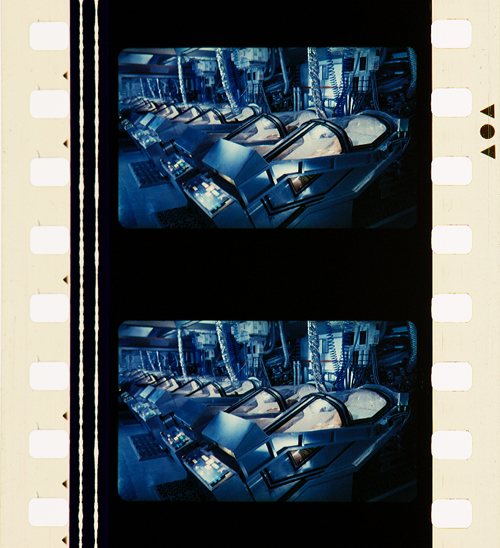
Eastman Color. Aliens (USA/Great Britain 1986, James Cameron). Credit: Academy Film Archive. Photograph of the Eastman Color Print Film Type 5384 by Joëlle Kost.
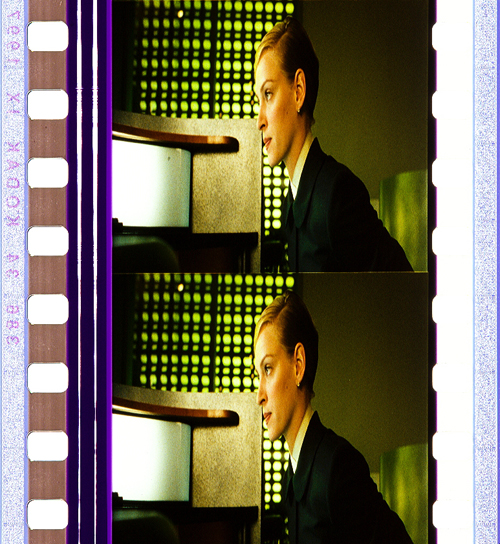
Eastman Color. Gattaca (USA 1997, Andrew Niccol). Credit: Library of Congress. Photograph of the Eastman EXR Color Print Film Type 5386 reference print by Barbara Flueckiger.
A plurality of styles emerged, less defined by technical limitations than by cultural contexts and individual preferences of filmmakers, art directors, costume designers, and cinematographers. Color aesthetics in film are not only created by hues, color schemes, and color contrasts, but also by lighting styles, by material properties of surfaces and textures, by depth of field, image composition, and by movement. The combination of these factors influences the image’s figure-ground relationships.
In the course of our research, we investigated a large corpus of more than 400 films – mainly from 1895 to 1995 – with a computer assisted workflow. A video annotation software has been developed based on our approach since 2017, when we figured out that tools available then were not well suited to the detailed annotation and visual analysis of film (color) aesthetics. The visual analysis and annotation software VIAN has been created by Gaudenz Halter in collaboration with the Visualization and MultiMedia Lab of the University of Zurich. The tools enable researchers to create detailed analyses including figure/ground separation and a large range of visualizations that make diachronic developments immediately evident or support the testing of new hypotheses.
A deepened understanding of color film technologies and aesthetics is an essential prerequisite for the scientifically sound digitization and restoration of color films, which is one of the most pressing topics today and therefore remains at the center of our research activities.
Acknowledgements
I would like to express my immense gratitude to Kristin Thompson and David Bordwell for publishing this blog post and for all the inspiration that guided my research.
A huge thank you to my teams ERC Advanced Grant FilmColors, SNSF Film Colors. Technology, Cultures, Institutions, ERC Proof-of-Concept VeCoScan.
Special gratitude is dedicated to all the film archives with their wonderful collections.
This project has received funding from the European Research Council (ERC) under the European Union’s Horizon 2020 research and innovation programme, grant agreement No 670446 FilmColors.
Repost: Our daily barbarisms: Leo Hurwitz’s STRANGE VICTORY (1948)
We have never reposted an entry before, but given recent events in US history, and the celebration of Martin Luther King’s legacy yesterday, and the impending inauguration of a new president tomorrow, we are re-running this entry, unrevised, from nearly four years ago.
It’s not just that it remains timely. (The interpolations remind us that Trump has been inciting violence from the start.) We wanted also to note that thanks to Milestone Films you can stream Strange Victory here. I plan to write more about the end of the Trump era in the days to come, but for now we can acknowledge the struggles ahead of us. We can be strengthened by recognizing that in 1948 people who had sacrificed far more than we have still sustained an urge to fight for decency and justice. –DB
DB here:
Leo Hurwitz is perhaps best known for Native Land (1942), the documentary codirected with Paul Strand and narrated by Paul Robeson. Strange Victory (1948) has been less easy to see. It was scarcely distributed and, though some reviews praised it, it was accused of Communistic sympathies. Now, restored and recirculated by the enterprising Milestone Films, Strange Victory has lost none of its compassion and righteous anger. Thanks to the energy of the Milestone team, led by A my Heller and Dennis Doros, every citizen has a chance, say rather a duty, to see a film whose force is undiminished today.
my Heller and Dennis Doros, every citizen has a chance, say rather a duty, to see a film whose force is undiminished today.
In a period of postwar optimism, Hurwitz and his colleagues dared to point out that the prejudices exploited by the Nazis remained powerfully present in the United States. The winners, it seemed, hadn’t repudiated the bigotry of the losers. American racism persisted and even intensified. The Nazis lost, but a form of Nazism won.
Dec. 14, 2015, in Las Vegas. Individuals at a Trump rally yelled “Sieg Heil” and “Light the motherfucker on fire” toward a black protester who was being physically removed by security staffers.
News of the world
Like The Plow That Broke the Plains (1936), on which Hurwitz was cameraman, and the Why We Fight series, Strange Victory is largely a compilation documentary. Guided by voice-over narration, it ranges across newsreels of Hitler’s rise, chilling combat shots, and footage from the liberated death camps.
But Hurwitz and his team shot a lot of new material as well, with an eye to bringing out the postwar significance of their theme. Newborn babies eye the camera, and kids play on sidewalks and in backlots (some shots recall Helen Levitt’s evocative street photos). Meanwhile, anxious adults approach a newsstand. “If we won, why are we unhappy?” the narrator asks at the beginning. The question is answered at the end: “There was not enough victory to go around.”
Thanks to a hidden camera, that newsstand becomes a sort of gathering spot, a place where people might encounter uncomfortable truths. Intercut with people buying newspapers are images of battles, as if the hunger for news aroused by the war didn’t dissipate. But what is that news? Hurwitz introduces it quickly: the rise of nativist bigotry. In an eye-blink, racist decals are slapped on fences, synagogues are smashed, and vicious pamphlets swarm through the frame. Race-baiting politicians, radio hate-mongers, and fascist sympathizers–the 1940s equivalents of our celebrity demagogues–are pictured and named. This is just one of many passages that guaranteed that Strange Victory could never be circulated on mainstream theatre circuits.
Hurwitz mixes found footage, stills, posed images, and fully staged scenes, such as the episode in which a Tuskegee Airman tries to find a job with an airline. In this mixed strategy he follows not only the precedent of the March of Time series but also, and more self-consciously, the Soviet documentarist Dziga Vertov.
In a 1934 article, Hurwitz called The Man with a Movie Camera “the textbook of technical possibilities,” and he isn’t shy about mimicking the master. Early in the film, portraying the Allies’ victory, a shot shows a swastika-emblazoned building blown to bits in slow motion. Later, to convey the return of Hitlerism, the same shot is run backward, reinstating the swastika on the building’s roof. A graphically matched dissolve equates a Klan wizard with Southern senator John Elliott Rankin.
Later, via constructive editing à la Kuleshov, parental pride is made color-blind, as both a white mother and a black one return a father’s glance.
The film hasn’t aged a bit. The print is gorgeously subtle black and white, and the score by the underrated David Diamond is warm in a chamber-music way. The film’s vigorous voice-over and its ricocheting images (some returning as refrains, bearing new implications) look forward to the hallucinatory, expanding associations created by our most biting contemporary documentarist, Adam Curtis.
 Shiya Nwanguma, a young African-American student at the University of Louisville, was shoved and verbally abused when she attempted to protest at the Trump event. “I was called a nigger and a cunt, and got kicked out,” Nwanguma said after the incident. “They were pushing and shoving at me, cursing at me, yelling at me, called me every name in the book. They’re disgusting and dangerous.”
Shiya Nwanguma, a young African-American student at the University of Louisville, was shoved and verbally abused when she attempted to protest at the Trump event. “I was called a nigger and a cunt, and got kicked out,” Nwanguma said after the incident. “They were pushing and shoving at me, cursing at me, yelling at me, called me every name in the book. They’re disgusting and dangerous.”
One of the individuals involved in the confrontation with Nwanguma was Joseph Pryor, a native of Corydon, Indiana, who graduated from high school last year. After the rally, Corydon posted a photo on his Facebook page that showed him shouting at Nwanguma. The post went viral and eventually attracted the attention of the Marine Corps, which Pryor had just joined.
The Marine Corps recruiting station in Louisville told military publication Stars and Stripes that Pryor had recently enlisted and was about to head off for boot camp. Captain Oliver David, a spokesman for the Marine Corps command, said Pryor had not yet undergone Marine Corps ethics training. . . . He added: “Hatred toward any group of individuals is not tolerated in the Marine Corps and he is being discharged from our delayed entry program effective [Wednesday].”
The tyranny of facts
As ever, the ordering of parts matters greatly. How best to convey the idea that after a struggle to cleanse Europe of violent prejudice, the same attitude is flourishing in America? You might think of couching your argument as a narrative. In chronological order, that would be: The rise of Hitler; the war defeating Hitler; the celebration of victory; the return of American bigotry in the postwar period. Clear and straightforward.
Hurwitz is more canny. Many films embracing rhetorical form, like the problem/solution structure of Pare Lorentz’s The River (1938), will embed brief narratives into their overarching argument. This is Hurwitz’s approach, but his stories aren’t chronologically sequenced. Instead, we start with the America of today before flashing back to the high price of defeating the Axis. “Everybody paid,” says the male narrator. “Everybody.” With a pause to register Roosevelt’s death, jubilation surges up as the Nazis fall. “For a day or two, the plain people owned the world.” But then we’re back to the newsstand and a montage of race-baiters and graffiti scrawlers.
Then, as we see a pregnant woman on a bench, we hear a woman’s voice. Her poetic musings reassure the newborn babies that they have a place here; she welcomes them to earthly love. Following the montage of haters with images of innocence casts a melancholy pall over these fresh-begun lives. They know nothing of the American brownshirts, but we know that they must learn our world.
This foreboding is confirmed by a chorus of name-calling over shots of newborns, the woman’s song of innocence is undercut by a song of bitter experience. A new male narrator (Gary Merrill) raps out the facts of “our daily barbarisms.” Get ready, he warns the babies: You will be tagged and vilified by how you look and where you live. “Separation of people is a living fact,” and they are future “casualties of war.” Throughout the rest of the film, the shots of children carry a terrible aura; they have no idea of what they’re facing.
Now, after a long delay, we flash back to Hitler’s rise. The Führer’s strategy, funded by the rich, is seen as a deliberate mobilization of just these tribal “facts” for the sole end of acquiring power. And where that process ends is the death camp. In a chilling visual refrain, the happy American toddlers are compared to troops of children marched along barbed wire.
The narrative spirals back to the beginning. Again we see Hitler defeated, again ecstatic celebrations–but not, as before, among civilians in cities. Instead, we see Russian and American soldiers fraternizing, and included in this mix is the black pilot, smiling serenely in his cockpit. His presence was foreshadowed by swooping aerial shots of the beginning. Now we’re back to the present, and he’s looking for work. No luck; maybe he can be a porter? A new montage generalizes his plight: American society refuses to assimilate African Americans. A savage cut takes us from a room full of white secretaries to a cotton field–the only work available for people who participated as fully in the war effort as anyone.
Now the early montage of Jim Crow images is recalled in a poetic string of associations on the word word, from Hitler’s control of The Word to signs barring blacks from entry, ending with inscriptions etched on forearms.
The final images of passersby, filmed unawares, replace the newsstand of the opening with shop windows as they peer inside. The sequence uncannily predicts the explosive consumer society that would follow in the war’s wake. Again, though, a shadow falls over the postwar world. Hurwitz daringly intercuts the intent window-shoppers with the plunder of the camps–hair, jewelry–and the numbers on inmate uniforms, as if these were commodities on display.
The war against inhumanity is far from over. Americans will need to be more than curious consumers if they are to face the struggle that lies ahead.
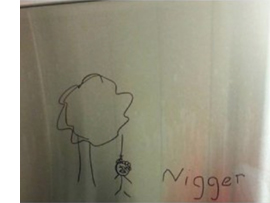 16 March 2016. UW-Madison police are investigating an act of racist vandalism that was committed earlier this week on campus, officials confirmed Wednesday. The drawing, which was found in a men’s bathroom in the Wisconsin Institute for Discovery, shows a stick figure hanging from a noose in a tree with the word “nigger” written next to it. UW police spokesman Marc Lovicott says the vandalism was reported at about 7:20 p.m. on Monday and is believed to have occurred some time between 3:30 and 7 p.m. that same day. (Photo by Marla DG on Twitter.)
16 March 2016. UW-Madison police are investigating an act of racist vandalism that was committed earlier this week on campus, officials confirmed Wednesday. The drawing, which was found in a men’s bathroom in the Wisconsin Institute for Discovery, shows a stick figure hanging from a noose in a tree with the word “nigger” written next to it. UW police spokesman Marc Lovicott says the vandalism was reported at about 7:20 p.m. on Monday and is believed to have occurred some time between 3:30 and 7 p.m. that same day. (Photo by Marla DG on Twitter.)
Strange Victory is, it seems to me, the essential documentary of our moment. A nearly seventy-year-old film can remind us that, as the narration puts it, “hopelessness is next door to hysteria.” The frustrations, despair, and hatreds that surfaced during Obama’s tenure have crystallized in an American fascist movement of unprecedented breadth. The film reminds us that scapegoating is eternal, sometimes summoned quietly (they’re not like us, she’s a traitor, he knows exactly what he’s doing), sometimes conjured up in full fury. At a moment when America is one IS attack away from a Trump or Cruz presidency, it’s good to be reminded how the well-funded Hitler exploited Us vs. Them. Temporizing pundits give every sufficiently funded lunatic the benefit of straight-faced interviews, or even tongue-baths. Right-wing politicians and agitators, keen on power and uncommitted to principle, are ready to fall in line behind a leader if he might win. Forget Godwin’s Law. Facing today’s assault on peace and justice, Strange Victory can rekindle our energies, without a moment to lose.
The crematorium is no longer in use. The devices of the Nazis are out of date. Nine million dead haunt this landscape. Who is on the lookout from this strange tower to warn us of the coming of new executioners? Are their faces really different from our own? Somewhere among us, there are lucky Kapos, reinstated officers, and unknown informers. There are those who refused to believe this, or believed it only from time to time. And there are those of us who sincerely look upon the ruins today, as if the old concentration camp monster were dead and buried beneath them. Those who pretend to take hope again as the image fades, as though there were a cure for the plague of these camps. Those of us who pretend to believe that all this happened only once, at a certain time and in a certain place, and those who refuse to see, who do not hear the cry to the end of time.
Milestone, who gave us the restored Portrait of Jason, has provided a very full presskit for Strange Victory here. My final quotation comes from Jean Cayrol’s text for Night and Fog (1955).
Strange Victory (1948).
When worlds collide: Mixing the show-biz tale with true crime in ONCE UPON A TIME . . . IN HOLLYWOOD
Once Upon a Time . . . in Hollywood.
Jeff Smith here:
Once Upon a Time…in Hollywood might turn out to be the buzziest film of 2019. Some of this water-cooler talk is due to its unusual status within an ever-enlarging field of true crime stories. (Call it a “not quite true” crime story.) Indeed, the genre is hotter than ever thanks to a bevy of new podcasts, telefilms, and miniseries.
Industry analysts, though, are also keen to interpret Once Upon a Time…in Hollywood’s box office fortunes. As that rare big summer release that is neither a sequel nor a franchise title, it can be seen as a test of whether original content can survive amidst heavily marketed, presold tentpoles.
The lesson so far? To quote William Goldman, “Nobody knows anything.” In The Washington Post, one unnamed studio executive warned, “I don’t see any blue-sky meaning here.” The executive added, “This movie has assets that almost no other film has. That’s what drove it.” At least one of those assets is Tarantino himself, who is a brand, if not a franchise. Fans know what to expect in a Tarantino film, which is why the film is sui generis when it comes to this summer’s slate. Due to its unique IP, it can’t really be compared with films like Men in Black International or Spider-man: Far from Home. Yet thanks to Tarantino’s larger than life presence, it also isn’t Long Shot or Booksmart or Stuber.
Once Upon a Time…in Hollywood is catnip to Tarantino nerds like me. It has the usual surfeit of references to obscure films and television shows. Some of these are deftly interwoven into the story itself. It boasts a carefully curated soundtrack that unearths “some-hits” wonders. It also contains scenes depicting nasty yet comical violence, a hallmark of Tarantino’s work ever since Reservoir Dogs.
At first blush, Once Upon a Time…in Hollywood would seem to be Tarantino’s most linear film. Yet it still displays certain continuities with his oeuvre in terms of story structure and technique. Although the film eschews the chapters and title cards found in Pulp Fiction and Kill Bill, it still contains elements of what David calls “block construction.” In the case of Once Upon a Time…in Hollywood, it is all about threes. The plot is structured around three days in the winter and summer of 1969: February 8th, February 9th, and August 9th. Each “chapter” is introduced showing the date via superimposed text. And all three chunks of narrative crosscut among the activities of three actors – Sharon Tate, Rick Dalton, and Cliff Booth – as they try to adapt to changes in the film and television industries.
If all of this assures that you’d never mistake Once Upon a Time…in Hollywood as the work of another director, other elements show Tarantino striking out in new directions. Chief among these is his mash-up of two normally distinct story types: the show-biz tale and the true crime yarn. Think of it as Singin’ in the Rain meets In Cold Blood. In what follows I outline some of the ways that Tarantino adapts his signature style to two well-established storytelling options: the multiple draft narrative and the network narrative. I also consider the effects Tarantino’s counterfactual history has on the conventions of the show-biz tale and the celebrity biopic.
My analysis contains major spoilers. If you haven’t seen Once Upon a Time…in Hollywood, stop reading now!
My world and welcome to it
Quick trivia question: what actor was on the cover of TV Guide during the week that Sharon Tate was murdered by the Manson family? Sharp viewers of Once Upon a Time…in Hollywood should know the answer. We see Tate’s housemate, Woychiech Frykowski, reading that issue of the magazine as he watches Teenage Monster on late night television.
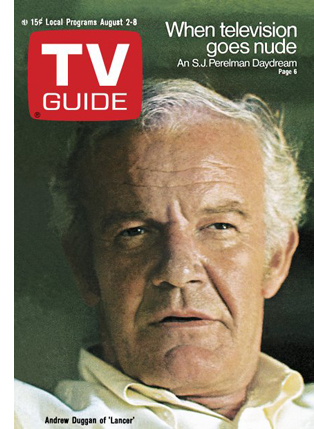 Give up? It was character actor Andrew Duggan, who played the cattle baron Murdoch Lancer on the TV show of the same name. Yes, that Lancer! The same one that featured Rick in a guest spot some six months earlier.
Give up? It was character actor Andrew Duggan, who played the cattle baron Murdoch Lancer on the TV show of the same name. Yes, that Lancer! The same one that featured Rick in a guest spot some six months earlier.
Tarantino’s film treats this little bit of pop culture ephemera as an uncanny coincidence. It simply becomes yet another way that he can intertwine the destinies of his three protagonists. But that brief shot got me thinking: did Tarantino start with the idea that he’d recreate whatever series was featured on TV Guide the week Tate was killed?
If so, Rick might have appeared just as easily as an aspiring cartoonist next to William Windom on the NBC sitcom, My World and Welcome to It. The show debuted just six weeks after Tate’s death. It is not unthinkable that NBC would have pushed for a cover on TV Guide in an effort to promote the premiere. Yet Tarantino’s counterfactual history in Once Upon a Time…in Hollywood would have been vastly different if that had been the case.
Did Tarantino really base his screenplay on this conceit? I doubt it. Lancer fits so snugly into the world that the director captures onscreen that it is not be so easily replaced. Tarantino seems to have a nostalgic fondness for the show, much as I did in my wasted youth. (I recall having a Lancer lunchbox at age six.) Production designer Barbara Ling describes the steps she took to recreate Lancer’s mix of Spanish/Western design. This involved adding adobe storefronts to the wooden ones, and substituting iron coils for wooden pegs on the saloon’s staircase. Ling added, “This was a [rich] cattle town and the buildings are two and three stories. It’s not Deadwood.”
Many critics have characterized Once Upon a Time…in Hollywood as another hangout movie. This is Tarantino’s designation for a film that is leisurely paced, fairly light on plot, and mostly gives the audience a chance to spend time with the characters. Indeed, because of these qualities, reviewers often compare Once Upon a Time…in Hollywood to Jackie Brown, a film that Tarantino himself compared to Rio Bravo, which was Howard Hawks’ hangout movie.
The resemblances don’t stop there. Once Upon a Time…in Hollywood’s three-headed protagonist bears certain similarities to Jackie Brown’s Jackie, Ordell, and Max.
Yet while watching Once Upon a Time…in Hollywood, I felt this film, more than any of Tarantino’s others, was an exercise in world-building. Normally we associate that term with sci-fi, fantasy, and comic book movies. It is especially important for transmedia properties where the fictional universe depicted exceeds the bounds of any individual film, television series, book, or video game.
Once Upon a Time…in Hollywood is also an alternate history, a type of speculative fiction also common in sci-fi and comic book stories. The Avengers: End Game and Spider-man: Into the Spiderverse are both relatively recent examples. This suggests a loose affiliation between Once Upon a Time…in Hollywood and other blockbusters even as Tarantino tweaks that formula by situating his speculative fiction within the generic framework of true crime.
Tarantino largely avoids the industrial motivations behind these two narrative techniques commonly seen in tentpoles. Instead, he simply recreates the pop culture world of his youth. In doing so, the director’s real world, his “realer than real” universe, and his “movie movie” universe all collide.
Keepin’ it real (and realer)
As Tarantino has explained in interviews, the “realer than real” universe is an alternate reality close to our own where his fictional characters can intermingle with real people. The “movie movie” universe, on the other hand, is a more overtly fantastic world closer in spirit to comic books or exploitation films. The characters have unusual abilities or even supernatural powers. The “movie movie” thus downplays the realistic motivations usually found in the “realer than real.” In Tarantino’s oeuvre, Reservoir Dogs and True Romance exemplify the “realer than real.” Kill Bill and From Dusk to Dawn are instances of the “movie movie.”
Each universe features a web of connections that can link particular tales together. For example, Kill Bill’s Sheriff Earl McGraw and his son Edgar pop up in Death Proof. Similarly, Lee Donowitz, the cocaine-sniffing movie producer in True Romance, is purportedly the son of Sgt. Donny Donowitz, the “bear Jew” in Inglourious Basterds.
In Once Upon a Time…in Hollywood, the most obvious references to these two Tarantino universes are the fictional brands he has created. During the end credits, we see Rick in a TV ad for Red Apple cigarettes. According to a Tarantino wiki, “ads or packs of these flavorful smokes” can be seen in The Hateful Eight, Inglourious Basterds, Planet Terror, Kill Bill, Pulp Fiction, From Dusk till Dawn, Four Rooms and Romy and Michele’s High School Reunion. (The latter is an obvious outlier. Yet the Red Apple nod was likely an in-joke related to Tarantino’s offscreen romance with Mira Sorvino, who played Romy.)
Similarly, Tarantino’s fictional fast food chain, Big Kahuna Burger, appears on a bus billboard in Once Upon a Time…in Hollywood. It previously was featured in a memorable scene in Pulp Fiction. (“That’s a tasty burger!”) But it had already debuted as a delicious snack devoured by Mr. Blonde in Reservoir Dogs. Big Kahuna later comes back in two other Tarantino films, From Dusk Till Dawn and Four Rooms, as well as Romy and Michele’s High School Reunion.
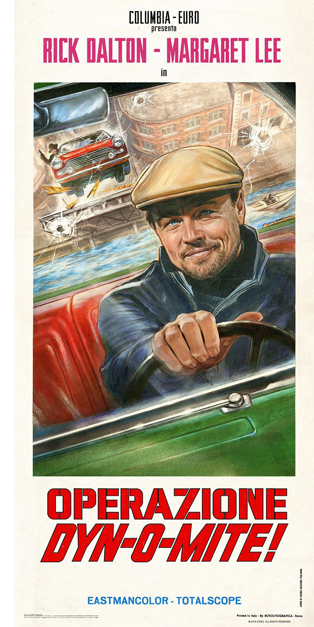 Other references to the “realer than real” are more arcane. In a montage sequence where Randy the Stuntman summarizes Rick’s experience starring in Italian films, we see a poster for Operazione Dy-no-mite, a James Bond knockoff directed by Antonio Margheriti. Fans of Inglourious Basterds will recognize “Antonio Margheriti” as the alias Donny Donowitz uses for the premiere of Nation’s Pride.
Other references to the “realer than real” are more arcane. In a montage sequence where Randy the Stuntman summarizes Rick’s experience starring in Italian films, we see a poster for Operazione Dy-no-mite, a James Bond knockoff directed by Antonio Margheriti. Fans of Inglourious Basterds will recognize “Antonio Margheriti” as the alias Donny Donowitz uses for the premiere of Nation’s Pride.
Much of the fun of Once Upon a Time…in Hollywood comes from the way Tarantino overlays these three universes to create a singular fictional world. For example, at one point we learn that Rick was considered for the role of Captain Virgil Hilts, the part played by Steve McQueen in John Sturges’ The Great Escape. Tarantino even inserts digitally altered footage of The Great Escape to show us a scene of Rick as Hilts. Since Rick claims he never met Sturges, this moment appears to represent an imagined version of the film that could exist in some type of alternate history. It invites us to consider how different Rick’s career might have been had fortune smiled upon him instead of McQueen.
To disentangle this knot, one must surmise that The Great Escape and Steve McQueen belong to both the real world and the “realer than real” world. Yet the scene of McQueen at the Playboy mansion and Rick describing his missed opportunity can only belong to the “realer than real.” And the character of Hilts himself exists only in the “movie movie” world. Hilts shares this status along with other characters Rick plays onscreen, such as Bounty Law’s Jake Cahill and The FBI’s Michael Murtaugh. After all, movie magic enables Cliff Booth to stand-in for Rick for scenes involving physical action. That two actors can play the same character within the same scene suggests that fictional personae in cinema have a unique ontological status quite different from the real world.
Arguably, the scene where Sharon Tate watches herself in The Wrecking Crew raises even more vexing issues about what is real and what is fictional. Unlike the clip from The Great Escape, the theatre screening shows the real Sharon Tate playing the character Freya in The Wrecking Crew. The fictional Sharon Tate watches the real Sharon Tate, along with the rest of the Bruin Theater’s audience. Yet, because Margot Robbie only pretends to be Sharon Tate for Tarantino’s camera, she doesn’t really watch herself playing the role. Obviously, Robbie belongs only to the real world. Yet Sharon Tate, as both an actual person and a fictional character, inhabits both the real world and the “realer than real world.”
Here the film indulges the Bazinian conceit that cinema has indexical properties. While making The Wrecking Crew, the film camera captured an imprint of the real Sharon Tate that preserved her being beyond the reaches of time and even death. In Once Upon a Time…in Hollywood, this moment is both joyful and sad. The viewer imagines the thrill that Tate feels in watching herself on the big screen, basking in the glow of incipient stardom. Yet the delight we experience is colored by our knowledge of what happened to the Sharon Tate seen falling on Dean Martin’s camera case. Unlike Robbie’s character, that Tate is doomed to a grisly death at the hands of psychopaths.
By film’s end, however, we are forced to reevaluate where Sharon Tate fits into Tarantino’s universe. When Cliff and Rick thwart the attack of Tex Watson, Susan “Sadie” Atkins, and Patricia “Katie” Krenwinkel, both Sharon Tates appear to move solely to the realm of the “realer than real.” Like the fictional Sharon Tate played by Robbie, the actress who appeared in The Wrecking Crew also lives on in a parallel universe created by the forking of time. And the fate of that character remains completely undetermined. Now fully a part of the “realer than real,” Tarantino’s Sharon Tate might eventually snort cocaine with movie producer Lee Donowitz or bum a Red Apple cigarette from Pulp Fiction’s Mia Wallace.
Once she joins the “realer than real,” almost any fate you could imagine for Sharon Tate seems possible. And it is that sense of the actress’ unlimited horizons that gives the ending of Once Upon a Time…in Hollywood its resonance. Sergio Leone’s Once Upon a Time films always situated viewers in the realm of myth. Once Upon a Time…in Hollywood, on the other hand, evokes the fairy tale.
Tarantino is known for his experimentation with narrative, and the simplicity of Once Upon a Time…in Hollywood’s “what-if” scenario could seem like a retreat from the formal play seen in his earlier films. Yet I’d argue that Tarantino’s merging of fact and fiction is even more audacious in certain respects. It strikes me as an unconventional example of what David calls “multiple draft narratives,” like Krzystof Kieslowski’s Blind Chance or Peter Howitt’s Sliding Doors. Once Upon a Time…in Hollywood gives us a second draft of history, albeit one where the key decision point is saved almost until the end of the film. And unlike Blind Chance or Sliding Doors, Tarantino doesn’t need to tell us what the different outcomes are for each of these tales. The first draft of history is one we already know.
In fact, the notion of multiple drafts offers a useful lens for all three films in Tarantino’s “counterfactual” trilogy. (The other two are Inglourious Basterds and Django Unchained.) In Groundhog Day, Source Code, and Edge of Tomorrow, each iteration of the basic situation shows the protagonist inching toward his goals. They gradually progress to the point where they are able to alter destiny, either theirs or the world’s or both.
Inglourious Basterds, Django Unchained, and Once Upon a Time…in Hollywood all present images of history not as it was, but as it should have been. Such counterfactual histories run counter to the norms of speculative fictions that often present us with dystopian worlds we were lucky to avoid. (Think Philip K. Dick’s The Man in the High Castle, Robert Harris’ Fatherland, or Kevin Willmott’s “mockumentary” C.S.A.: The Confederate States of America.) All of these stories depend upon our knowledge of the first draft of history. Yet Tarantino gives us second drafts that right particular historical wrongs in either small or large measure. In doing so, Tarantino gives us versions of history that are closer in spirit to his favorite movies. All three films in the “counterfactual” trilogy feature tidy resolutions. Once Upon a Time…in Hollywood, however, is even more self-conscious about the way Tarantino’s second draft of history takes the form of a “movie movie” climax. The realer-than-real version is the one we ought to prefer.
Paging Mr. Melcher, Mr. Terry Melcher…
If Tarantino’s conflation of fact and fiction evokes certain traits of the multiple-draft narrative, his vivid recreation of Hollywood circa 1969 illustrates another type of story popularized in American independent films and various art cinemas: the network narrative.
Tarantino has broached this form before in Inglourious Basterds. There he moves back and forth between three mostly independent storylines: 1) the Basterds’ guerrilla campaign against German soldiers, 2) Archie Hicox and Bridget von Hammersmarck’s initiation of Operation Kino, and 3) Shosanna’s plan to avenge her family’s deaths during the premiere of Nation’s Pride. SS officer Colonel Hans Landa threads through all three storylines. He orders the killing of Shosanna’s family in the opening scene. Later he shares apple streudel with Shosanna in a Paris café. Landa also investigates the scene where Hicox has been killed. In the climax, he interrogates Bridget in a scene that contains a grim allusion to Cinderella’s lost slipper.
Finally, Landa negotiates a deal with Aldo Raine’s superiors that guarantees his immunity from prosecution for war crimes.
Once Upon a Time…in Hollywood is obviously much less plot-driven than Inglourious Basterds. Yet, as noted above, it shares a similarity in the way it interweaves the stories of three characters: Rick, Cliff, and Sharon.
It’s frequently said that Hollywood is a company town. By situating all three characters within the film and television industries, Tarantino tacitly stays faithful to that truism. The protagonists’ shared profession also facilitates the kinds of attenuated links between stories commonly found in network narratives.
Part of the fun of Once Upon a Time…in Hollywood comes in recognizing the “six degrees of separation” that join all of these people, both real and fictional, in the same entertainment ecosphere. Take, for instance, one decidedly minor character: actress and singer Connie Stevens, played by Dreama Walker. At the Playboy Mansion party, Stevens listens to Steve McQueen explain the romantic triangle that has Sharon living with her current husband, Roman Polanski, and her ex-boyfriend, Jay Sebring. Stevens, though, is the ex-wife of actor James Stacy, who played Johnny Madrid in Lancer. Stacy (played in our film by Timothy Olyphant) is Rick Dalton’s scene partner for the episode of Lancer that Dalton hopes can spur his comeback. Dalton is Sharon Tate’s neighbor on Cielo Drive, the same house that Charles Manson targets as the site of the “family’s” first murder. This circuit even loops back on itself. When Stacy and Dalton first meet on set, Stacy asks Rick whether it was true that he almost got a part in The Great Escape, the same part played by McQueen.
Two characters in Once Upon a Time…in Hollywood serve as nodes that connect all three storylines together. The first is Cliff, Rick’s stunt man and gofer. Although not a resident at Cielo Drive, he spends a lot of time in Rick’s home and thus is privy to what happens in Sharon’s abode. This is especially evident when Cliff repairs Rick’s fallen TV antenna. The camera is aligned with him as he overhears Sharon playing a Paul Revere and the Raiders album. He also notices Charles Manson approaching the Polanski residence. Tarantino’s casting of Damon Herriman as Manson is likely an allusion to the television show, Justified. Herriman played Dewey Crowe alongside Olyphant.
Justified was also an adaptation of Elmore Leonard’s “Raylan Givens” books. Tarantino has long admired Leonard’s work as a writer of both westerns and crime novels.
Employing a redundancy that befits Hollywood storytelling, Cliff gets linked to Sharon’s storyline in other ways. While working as Rick’s stunt man for an episode of The Green Hornet, he gets involved in a dust-up with Bruce Lee. Lee gave Sharon Tate some pointers on fighting as she prepared for her role in The Wrecking Crew. And in real life, the martial arts legend was recommended for the role of Kato on television’s The Green Hornet by Sebring, Tate’s former boyfriend.
Perhaps Cliff’s most important role in the film’s network involves his dalliance with Pussycat, one of the many young women who viewed Manson as a kind of guru. Cliff picks up Pussycat as a hitchhiker and gives her a ride back to the Spahn ranch. Having worked on the ranch back when it was an active production site, Cliff grows concerned for the safety of its owner, George Spahn. Cliff notices how the Manson clan has taken over and is troubled by its weird vibe. Determined to see George for himself, Cliff forces his way into George’s house over the objections of the Manson girls, especially Squeaky. George seems careworn, but Cliff finds that there is little he can do for him.
When Cliff sees a pocketknife sticking out of his front tire, he confronts Clem, one of Manson’s followers. The conflict becomes physical. Cliff breaks Clem’s nose with one punch and then proceeds to beat him to a bloody pulp.
This proves to be a dangling cause that gets resolved in the film’s climax when Cliff recognizes Tex, Sadie, and Katie as people he met at the Spahn ranch.
The other character who links the storylines together is one we never see: record producer Terry Melcher. Melcher is the “Terry” that Manson mentions when he visits Cielo Drive in the scene described above. Later, Tex reminds Sadie, Katie, and Linda that Charlie directed them to go to the place where Terry Melcher lived and kill everyone inside.
Although these are the only explicit references to Melcher, he is indirectly represented in several other aspects of the film. Here it helps to know a little about Melcher’s career and Manson lore. Even if Melcher’s name draws a blank, you likely know many of the bands he worked with: the Byrds, the Mamas and the Papas, and Paul Revere and the Raiders.
All these musicians crop up in one way or another in Once Upon a Time…in Hollywood. Melcher’s last major credit of the 1960s was as producer of the Byrds’ Ballad of Easy Rider. When Rick berates Tex for parking his car on Cielo Drive, he yells, “Hey, Dennis Hopper! Move this fucking piece of shit!” Rick’s insult fits with his general disdain for hippies. But it also alludes to Easy Rider by comparing Tex’s look to that of Hopper’s character, Billy.
Two of the Mamas and the Papas – Michelle Phillips and Cass Elliot – both appear in the party scene at the Playboy mansion.
We also hear the Mama and the Papas’ big hit, “California Dreaming” in a cover version by Puerto Rican singer José Feliciano. And when the car driven by Tex crawls up Cielo Drive, the music issuing from the Polanski residence is the Mamas and the Papas’ “12:30: Young Girls are Coming to the Canyon.” Even before Tex’s directive to the Manson girls, Tarantino has given us a subtle reminder that Melcher was Charlie’s intended, if indirect, target.
Finally, Sharon plays Paul Revere and the Raiders’ “Good Thing” and “Hungry” on a hi-fi in her bedroom.
The choice of music is especially fitting since the band’s lead singer, Mark Lindsay, lived in the same house on Cielo Drive with Melcher and his then girlfriend, Candice Bergen.
Beyond these musical references, Melcher’s history with Manson informs Once Upon a Time…in Hollywood in another way. Melcher recorded some demos of Manson’s songs, and even discussed making a documentary about Manson’s commune at the Spahn Ranch. In testimony at trial, Melcher said that any possibility of a record contract with Manson was sundered when Charlie asserted that he’d never join a musicians’ union. Manson’s staunch refusal was rooted in his desire to avoid entanglements with the establishment. Yet union membership was a condition for any contract with Melcher’s label, Columbia records. Another factor in Melcher’s decision was his assessment of Manson’s talent. Charlie couldn’t sing.
Although Melcher publicly stated that he only considered Manson’s musicianship, he privately expressed concerns about Charlie’s mental stability. These were heightened when he visited the Spahn Ranch and witnessed Manson in a physical altercation with a drunken stunt man. Tarantino more or less recreates this episode in his film, substituting Cliff for the unnamed stunt man and the hapless Clem for Charles Manson.
More importantly, Melcher is the son of screen legend Doris Day and stepson of agent/manager/producer Martin Melcher. In Once Upon a Time…in Hollywood, he becomes the ideal, if absent, symbol of the combined worlds of music, television, and film that Tarantino so lovingly details.
How the West was lost
Los Angeles circa 1969 is presented as the epicenter of the American entertainment industries. It’s a place where a hairdresser like Jay Sebring rubs shoulders with action stars, TV cowboys, ingénues, film directors, and pop stars –and make $1000 a day to boot! The constant stream of hits from KHJ radio is as ubiquitous as the many movie posters, billboards, and theater marquees that feature Hollywood’s latest and greatest.
Tarantino’s press kit for Once Upon a Time…in Hollywood makes reference to Joan Didion’s famous observation in “The White Album” that “the Sixties ended abruptly on August 9, 1969, at the exact moment when word of the murders on Cielo Drive traveled like brushfire through the community.” Most critics take Didion’s reference to the Sixties as shorthand for the end of the “peace and love generation.” Yet Tarantino’s slightly revisionist take suggests it’s not only the youthquake that died, but also a certain strain of Hollywood filmmaking that passed with it.
Although I don’t doubt their historical accuracy, the litany of titles that appear throughout Once Upon a Time…in Hollywood feels as curated as any of Tarantino’s music soundtracks. Some, like 2001: A Space Odyssey, are films that entered the canon of great sixties cinema. Others, like The Night They Raided Minsky’s, are early films by directors who’d later achieve greatness. (In this case, William Friedkin, who won an Oscar in 1972 for The French Connection.)
But many, like Lady in Cement, Tora, Tora, Tora!, Krakatoa: East of Java, Mackenna’s Gold, C.C.& Company, and even The Wrecking Crew, are largely forgettable movies.
Tarantino clearly has affection for all of the drive-in theaters and Hollywood picture palaces where these titles played. But the titles themselves are evidence of the industry’s struggle to adapt to new tastes and a rapidly changing media landscape. Old-school show biz types, like Dean Martin and Frank Sinatra, continued their success as singers and television personalities. But their careers as actors had functionally ended by 1969. And the efforts to keep them relevant often seemed either strikingly anachronistic or just plain weird.
In the opening scene of Lady in Cement, Frank Sinatra fights off a small school of sharks while he is examining the body of a nude woman who, like Luca Brazzi, sleeps with the fishes. And yes, the scene is as ludicrous as it sounds. If this is what became of Hollywood’s once great tradition, it is hard not to think we should just let it pass.
Yet, the fear of obsolescence also explains the oversize role that Tarantino gives to the Western as part of this changing landscape. True Grit and The Wild Bunch were among the summer of 1969’s biggest hits. Butch Cassidy and the Sundance Kid would eventually become the year’s top-grossing film. All three Westerns feature cowboy heroes that are either aging, outmoded, or both. They reminded contemporary viewers that horse riders would soon yield to horseless carriages, the lone bounty hunter would soon be supplanted by paramilitary detective agencies, and the humble six-shooter can’t match the lethal power of a Mexican army machine gun.
In retrospect, though, the popularity of the Western in 1969 represents the genre’s last gasp. Studios continued to make Westerns during the 1970s, but only three – Jeremiah Johnson, The Outlaw Josey Wales, and The Electric Horseman – would surpass $10 million in rentals in the entire decade.
On television, such long-running series as Gunsmoke, Bonanza, and The Virginian had their last round-ups. The networks tried their hands at new Westerns, like Alias Smith and Jones (below), Hec Ramsey, Dirty Sally, and Lancer, but they were all short-lived. At the start of the 1980s, the genre was completely moribund. Subsequent efforts to recapture the Western’s former glory were mostly the equivalent of flogging a dead pony.
As a total cinephile, Tarantino is entirely aware of this aspect of the genre’s history. This is signaled quite explicitly in the decrepit condition of the Spahn Movie Ranch. Yet Tarantino also uses Rick’s career arc to signify its downward trajectory.
No character in Once Upon a Time…in Hollywood is as strongly associated with the Western as Rick. His home is filled with collectibles like his Hopalong Cassidy coffee mugs. His walls are decorated with posters for The Golden Stallion and A Time for Killing. On set, he reads pulp oaters like Ride a Wild Bronc to relax between takes.
By using Rick to dramatize the twin declines of both Old Hollywood and its “bread and butter” genre, the narrative arc of Tarantino’s drugstore cowboy is one suffused with nostalgic melancholy. The key moment in Once Upon a Time…in Hollywood occurs when Rick breaks down telling the story of Easy Breezy to Trudi Fraser, his Lancer co-star. He describes Easy “coming to terms with what it’s like to feel slightly more useless each day.”
The various threads of Once Upon a Time…in Hollywood’s network finally knot together in the Manson family’s attack on Cielo Drive. At the moment of truth, it is telling that Rick reaches not for a firearm, but for the prop flamethrower he wielded in The 14 Fists of McCluskey. By recalling the moment when Rick shouts, “Anyone here order fried sauerkraut?”, Tarantino reminds us that violent spectacle and snappy quips will eventually replace the Western’s ritualistic showdowns.
Still, it is a musical allusion to the Western that gives Once Upon a Time…in Hollywood its final grace note. Cliff and Rick have thwarted the Manson family’s attack. The ambulance takes Cliff to the hospital. Rick offers an explanation of what just happened to his neighbors. Jay recognizes Rick as television’s Jake Cahill. Via the intercom, Sharon invites him to come up for a drink. As Rick walks to the house, we hear the start of Maurice Jarre’s “Lily Langtry” [sic] from his score for The Life and Times of Judge Roy Bean.
John Huston’s film begins with an expository title shown below that highlights the western’s tendency toward self-mythology. It is especially apt for Once Upon a Time…in Hollywood’s counterfactual history.
Jarre’s cue, though, appears in a scene where the renowned actress Lillie Langtry finally visits Judge Bean’s Texas town. Langtry is given a tour of the Bean’s house, now converted into a museum that also acts as a shrine to her. Bean worshipped Langtry, but tragically dies before he gets to meet her. Tarantino inverts both Huston’s sad ending and its dramatization of missed opportunity. By altering the course of history, the cowboy in Once Upon a Time…in Hollywood gets to be the real-life hero rather than the TV heavy. Rick also gets to meet the actress he’s admired from afar. Rick and Sharon are still both married to other people. But their chance meeting in the film’s epilogue feels more than anything like a dream fulfilled.
A star is unborn
In the previous section, I dwelt on the role of the Western in Once Upon a Time in Hollywood because of its symbolic significance in capturing a particular historical moment. But Tarantino borrows quite freely from another narrative prototype: the show-biz tale. In fact, while walking out of Once Upon a Time…in Hollywood, I wondered aloud if it was Tarantino’s twisted take on A Star is Born.
Like A Star is Born, Once Upon a Time…in Hollywood centers on a male performer whose career has started to decline and a female newcomer whose star is on the rise. Moreover, Rick’s drinking problems create an obstacle to his comeback in much the same way that alcohol contributes to the downfall of the male protagonists in all four versions of A Star is Born.
Tarantino, though, subtly alters this template in two ways. First, he depicts his two stars as neighbors rather than as a romantic couple. Secondly, he cleverly depicts Rick’s career arc as an inverse mirror of Sharon’s.
Tate was an Army brat who grew up in Europe. Her earliest work was as an extra in Italian films. She moved to Hollywood in 1962 and got her break playing Jethro Bodine’s girlfriend on The Beverly Hillbillies. In the mid-sixties, Tate made the move to films, appearing in Eye of the Devil and The Fearless Vampire Killers.
It was during production of the latter that Tate met her future husband, Roman Polanski. Tate’s role in Valley of the Dolls further enhanced her status as an “up and comer.” In 1968, Tate earned a Golden Globe nomination in the category of “Most Promising Newcomer — Female.”
In direct contrast, Rick’s career begins in Hollywood and ends in Italy. Rick enjoys early success with Bounty Law and The 14 Fists of McCluskey. But soon finds himself reduced to guest star roles on television. Against his better judgment, Rick agrees to star in four Italian quickies. Two of these are spaghetti westerns directed by Sergio Corbucci, a Tarantino fave who created the popular “Django” character. Rick returns to Hollywood but his future is uncertain. He could be the next Clint Eastwood, star of A Fistful of Dollars and The Good, the Bad, and the Ugly. Or he could be the next Richard Harrison, star of $100,000 Dollars for Ringo and Secret Agent Fireball.
If this were all there was to the comparison, it would hardly be worth mentioning. But Tarantino hints at other parallels through a much more obscure and convoluted cinematic reference. An auteur as shrewd as Tarantino would undoubtedly remember that the Rolling Stones’ “Out of Time” –used in Once Upon a Time…in Hollywood under shots of Rick’s return from Rome – was previously featured in the opening sequence of Hal Ashby’s Coming Home.
The connection to Ashby’s film is strengthened by the casting of Bruce Dern as George Spahn, a role originally intended for Burt Reynolds. Early in his career Dern played Jane Fonda’s uptight, martinet husband in Coming Home. More importantly, during Coming Home’s climax, Dern’s character commits suicide by wading into the ocean to drown himself, just as James Mason does at the conclusion of George Cukor’s version of A Star is Born.
Which brings us back to Once Upon a Time…in Hollywood’s controversial ending. Earlier I discussed the resemblance between its counterfactual history and multiple draft narratives. Here I want to discuss it as an illustration of the caprice of fame.
Much more than the endings of Inglourious Basterds and Django Unchained, the climax of Once Upon a Time…in Hollywood feels both resolved and unresolved. Hitler’s violent death in Inglourious Basterds surprised audiences who first saw it in theaters. Yet the historical record indicates that the Basterds simply saved Hitler the trouble of later killing himself and his wife, Eva Braun. At the conclusion of Django Unchained, the protagonist’s revolt clearly hasn’t ended slavery as a “peculiar institution.” But its story of personal revenge remains deeply satisfying.
The ending of Once Upon a Time…in Hollywood left me with more questions than answers. I get it. Sharon Tate lives instead dying at the hands of the Manson family. Tarantino gives us the Hollywood happy ending that this story lacked in reality. But what’s next?
Do the deaths of Tex, Sadie, and Katie mean that Leno and Rosemary LaBianca also survive? Maybe. Perhaps the loss of three members of the cult might cause the others to reevaluate their loyalty to Manson. Perhaps Manson himself would reevaluate his plan to trigger a race war.
But maybe not. If Manson were the hero of Tarantino’s grindhouse climax rather than its villain, one could easily imagine the film running another twenty minutes with Manson vowing to get even. You might imagine it as something like the surprising “second climax” of Django Unchained. After mourning the loss of his compatriots, Charlie would proclaim. “The fires of Hell will descend upon the Hollywood hills. This time it’s personal.”
Perhaps the bigger question is whether Sharon continues to be the “It” girl during the next phase of her career. The allusions to A Star is Born suggest a steady upward trajectory. But the reality is that success depends upon a certain amount of luck. It is never assured. A few box office bombs and Sharon Tate might be reduced to the same sort of TV guest spots that Rick is doing.
In this way, the ending of Once Upon a Time…in Hollywood asks us to consider a potential paradox. Did Sharon Tate become more famous in death than she ever would have been in life?
The theme of talent tragically cut down in the prime of life is a hoary cliché of the celebrity biopic. Tarantino is smart to steer clear of it. Yet whenever we watch a film like Prefontaine, Beyond the Sea, or Lenny, one starts to wonder, “Would anyone bother to make this film if its subject had lived?”
To be sure, the totality of Once Upon a Time…in Hollywood shuns any pat answer. Cass Elliot of the Mamas and the Papas died at age 32. Initial reports said she choked on a ham sandwich in the midst of having a heart attack. I remember the media reports when Mama Cass passed in 1974. But does anyone who didn’t live through that moment?
James Stacy, star of Lancer, nearly died in a deadly motorcycle accident. (Tarantino hints at this fate by showing Stacy, sans helmet, riding his steel horse away from his trailer.) Stacy survived, but lost an arm and a leg as a result of his near fatal injuries. He eventually made a comeback in 1977 and even earned an Emmy nomination for his work on Cagney and Lacey.
Yet, if you mention James Stacy during dinner conversation tonight, I suspect your companion will ask, “Who?”
And then there is the scene where Pussycat and the other Manson girls walk past a large mural of James Dean in his iconic pose from Giant. Dean was certainly famous during his lifetime. But he became a legend at age 24 after his Porsche Spyder collided with another car, snapping his neck.
Would Sharon Tate have achieved stardom had she lived? God only knows. I certainly don’t. I do know one thing, though. Being a victim of the “crime of the century” preserved Tate’s image in popular memory with a vividness that very few human beings on this earth ever achieve.
Margot Robbie’s performance as Tate is extraordinary. She reminds modern viewers of the verve, spirit, and sensuality that Sharon brought to the screen. Yet it is the image of Tate as a tragically murdered heroine that Tarantino, like Mark Macpherson in Laura, appears to have fallen in love with. And it is this image that continues to haunt me some fifty years after Tate’s death.
Thank you to David and Kristin for their comments onf an earlier draft of this post. Thanks also to JJ Bersch and Maureen Rogers for letting me bounce some of ideas off them.
Vincent Bugliosi’s Helter Skelter: The True Story of the Manson Murders remains the most comprehensive account of the Tate-LaBianca murders. Tom O’Neill, though, has spent the last 20 years investigating Manson’s crimes. His new book, Chaos: Charles Manson, the C.I.A., and the Secret History of the Sixties, claims that Bugliosi’s investigation was deeply flawed. Instead, his research suggests that Manson was a drug trafficker and C.I.A. operative. For O’Neill, the notion that Bugiliosi saved Los Angeles from a hippie death cult is wrong. The motive for the crimes was both simpler and more quotidian. All of Manson’s murders were the result of drug deals gone wrong. An interview with O’Neill can be found here.
The story that Terry Melcher witnessed a fight at the Span Movie Ranch between Charles Manson and a drunken stunt man sounds apocryphal. Yet it appeared in The Telegraph’s obituary for Melcher, which was first published in 2004. I haven’t been able to independently corroborate that story with another source. However, even if it isn’t true, it is part of Manson lore. I saw the same story repeated on at least three other websites. Doris Day’s death in May spawned the publication of a handful of articles about her relationship with Terry. They can be found here, here, and here. An brief overview of Melcher’s career as a record producer can be found in Rolling Stone’s obituary.
For those interested in learning more about Sharon Tate’s life, I recommend Sharon Tate: Recollection. It was written by Tate’s mother Debra. It also features a foreword by her husband, Roman Polanski.
Mark Harris’s Pictures at a Revolution: Five Movies and the Birth of the New Hollywood and Peter Biskind’s Easy Riders, Raging Bulls survey the momentous changes taking place in the film industry during the late 1960s.
Bruce Fretts provides a fairly thorough overview of Once Upon a Time…in Hollywood’s voluminous pop culture references.
Several articles have also appeared that address different aspects of the film’s production. An interview with choreographer can be found here. Cinematographer Robert Richardson and production designer Barbara Ling detail their efforts to recreate the sets of the TV show Lancer here. Richardson also discussed Once Upon a Time…in Hollywood’s visual influences in a Hollywood Reporter podcast.
An interview with Mary Ramos, Once Upon a Time…in Hollywood’s music coordinator, can be found here. Guides to Once Upon a Time…in Hollywood’s music soundtrack can be found here, here, and here.
An analysis of Once Upon a Time…in Hollywood’s box office implications is found here.
Finally, the release of Once Upon a Time…in Hollywood has occasioned a number of think pieces that address aspect of the film’s counterfactual history and its identity politics. Here philosopher David Bentley Hart discusses the moral implications embedded in Tarantino’s counterfactual trilogy.
Once Upon a Time…in Hollywood’s gender politics is addressed here. The author, Aisha Harris, compares Tarantino’s depiction of Sharon Tate to other female characters in his filmography. Finally, zeitgeist readings of Once Upon a Time…in Hollywood in relation to the current political landscape can be found here and here.
Once Upon a Time . . . in Hollywood.
Kindest, E.: A memoir of Edward Branigan
Equinox Flower (1958).
DB here (but writing for Kristin too):
Edward Branigan died on Saturday, 29 June, in Bellingham, Washington. He had fought for a year against Acute Myeloid Leukemia. He was 74.
Edward was an ambitious, highly original film theorist. His first book, Point of View in the Cinema (1984) has become the definitive study of the creative POV options available within “classical” filmmaking. Narrative Comprehension and Film (1994) is a sweeping account of the viewer’s activity in ascribing meaning to stories on the screen. Projecting a Camera: Language-Games in Film Theory (2006) is a meta-level account of how critics and theorists talk about films; it teases out different capacities and qualities we assign to “the camera.” Edward’s last book, published in December 2017 is Tracking Color in Cinema and Art: Philosophy and Aesthetics. It ranges across physics, psychology, art history, and philosophy (mostly Wittgenstein) to explore how we understand and appreciate color imagery.
Edward was also a prodigious editor, producing with Warren Buckland The Routledge Encyclopedia of Film Theory (2015) and with Chuck Wolfe the American Film Institute Readers, a series of forty anthologies on a huge range of topics. He taught at UCLA and Iowa, but his tenure home was UC–Santa Barbara, where he started in 1984 and remained until retiring in 2012.
Keeping in touch
Edward and Evan Branigan, 1984.
So much for a bare-bones Wikipedia entry; Edward deserves a full-blown one as soon as possible. What even that couldn’t capture is the intense admiration, even devotion, he aroused in students and colleagues. He won many teaching awards, including a Distinguished Service Award from the graduate students of his department. For his peers in the profession he was a reliably easygoing, cheerful presence in the sometimes chilly corridors of academe.
Kristin and I met Edward in 1974, and we kept up with his life (one far more dramatic than ours) as best we could, separated by half a continent. Over the decades we visited him occasionally in Santa Barbara and Los Angeles. For too-few times he returned to Wisconsin for summer vacations. Our last reunion was in September of 2016 at a Seattle coffee house.
My email records before 2004 have gone astray, but after that I count over 400 messages, some very long. I could fill this entry with remarkable passages, and I expect other correspondents have equally plump archives. From 2007:
John [Kurten] and I have had three consecutive movie binge weekends. it’s a treat to start watching films in the afternoon and never think about stopping (more or less for two days at a time) — isn’t this what the profession promised?
He often wrote to correct mistakes I made in books and essays, so getting this reaction to my In the City of Sylvia entry left me elated. (Fortunately for me, he hadn’t seen the film yet.) One sequence perfectly fulfilled the conditions he laid out in his POV book.
You madman, it’s brilliant. Your latest blog. Maybe the film, too. From what you say, I thought of layers and uncertainties, intersections and random slidings. Open expectation or expectation opened. Is *Sylvia* for the point-of-view shot, i.e. for a point in space, what *The Conversation* was for sound, *Blow-up* for the photograph, *Time Regained* for memory, and etc.?
When I discovered a “Hitchcock supercut” compiling favorite motifs and themes, I was reminded that in the pre-digital era Edward had mounted something similar for his course.
Thanks for this link. . . . I did teach Hitchcock a number of times in the mid-to-late 80’s. My final lecture was exactly and precisely as described on the link you sent. All (almost) of Hitchcock’s films were represented on two Kodak Carousel projectors jammed full. I projected two simultaneous images side by side of visual motifs (staircases, camera movements…etc.). Slow dissolves between each pair of images to the next pair. I made a music tape and keyed certain images to climaxes in the music. Only taught the course in the 80’s. Seems an age ago. Not to mention the changes in technology. I have ten metal cases of slides that are orphans now with no projectors. As do you and Chuck [Wolfe] with many more cases. I had some of my slides digitized, but the quality was disappointing.
But later he reports his house fire:
I have realized that my eight cases of 35mm slides taken directly from 16mm prints — collected since 1974 — are gone in the fire, including a slide from every setup of An Autumn Afternoon.
Speaking of Hitchcock, in 2012 I told him that Sir Alfred would have a place in the book I was planning on the 1940s. This got him going:
Mr. missed D.,
Rethinking Hitchcock! I want to read it. . . . Nice to hear from you generally and I trust you and KT to be well. I suspect the latter has seen The Hobbit many a time so far and planning still more viewings. Nicholas and I are in Seattle. This morning after a large breakfast (omelet, steel-cut oatmeal, hash browns, muffins, black tea) I watched out a tenth floor window as the monorail docked at the Space Needle, while visiting my parents and the other Usual Suspects (i.e., relatives), and planning further hiking, movies, bridge, serious eating, shopping ski apparel activities, and so forth. It’s fairly deeply relaxing here. (It suggests what retirement could be for me in Summer 2014, retirement being in name only at the moment.) I saw two float planes land on Lake Union, taxiing to the shore, water spraying up over the floats, red and green lights continually snapping on and off on both wings (i.e., not one red on the left wing, one green on the right wing). Interstate 5 is in the distance, the car headlights of morning commuter traffic turning it into a winding white snake as the day is strongly grayish, clouds about 40 stories up, swirling, banking up, no sign of sky (thus solar panels are useless), the Olympic Mountains are in the distance, people are walking on the streets below this way and that with purpose, with destinations firmly in mind. Have I mentioned the large rotating, neon pink elephant sign glimpsed in the distance between some buildings that advertises simply, “Car Wash,” as if it doesn’t rain often in Seattle? The sign stops briefly on every rotation to shine out its message in white neon bulbs, “Car Wash,” the message never changing. Up here I’m living in a parenthesis. Looking out at a vast aquarium.
He never forgot my birthday. This is from 2014, as is the photo at the bottom.
HB, big guy. Wherever you are, it’s still HB. Thinking of you.
I’m traveling for a month, meeting many persons, hiking above the treeline in the Rockies, World Lacrosse Championships, Denver, Boulder, Fort Collins, Estes Park, The Stanley Hotel (think The Shining), Seattle, northern Wisconsin, seeing all the sons, and more. Consulting on two legal cases. Have no time. Retirement is the bestest. Even trying to write.
From 2018:
I’ve seen Blade Runner 2049 seven times. A masterwork. Been drinking the Blade Runner Director’s Cut Johnnie Walker Black Label Scotch in the film’s Italian crystal glasses. Watched all sixteen episodes of the Netflix series, Babylon Berlin, in three nights. Should interest you in terms of detective fiction. First-rate fun. Weimar seems like hell with all its circles intact. It’s not up to Fassbinder’s Berlin Alexanderplatz, but what is?
During his cancer treatments, he managed to keep corresponding. Although the paragraphs got shorter, the tone never changed. This from May of this year:
I appreciate your generous words and kind thoughts. I haven’t been feeling well. The blasts have been creeping back. . . . More chemo is likely, maybe a clinical trial. . . .
Enemy. The film streams on Netflix. Take a look. Don’t read anything about it, and its shocks, until it settles on you.
Game of Thrones ends tomorrow for all time until the HBO prequel is ready. I think Dany is killed by Ayra disguised as Tyrion. Jon Snow moves the Iron Throne to Westeros with him upon it.
He inevitably signed these energy bursts, “Kindest, E.”
The 70s: Beyond the New Hollywood
Wisconsin Film Society poster, 1970.
My most vivid memories come from the years we knew him as a student and friend here in Madison. He was part of a thriving intellectual community that, from the distance of today, informed our lives in deep and lasting ways.
Edward, Vietnam veteran (Marines, Communications), took a film course with me in spring 1974, his final year of law school at UW. It was my second semester of full-time teaching. He then signed up for our graduate program. I shouldn’t have been surprised by his shift of career. As an undergraduate he had majored in Electrical Engineering and English. He also wrote poetry.
He entered a community bursting with talent. When I got here in 1973 I was handed four superb TA’s: rigorous and righteous Doug Gomery, witty and charming Brian Rose, meticulous silent-film aficionado Frank Scheide (who looked like a young Buffalo Bill), and already stunning experimental filmmaker James Benning. There was Maureen Turim, fresh from a year in Paris and immersed in Bresson and the avant-garde; Diane Waldman, who’d write the still-definitive account of Hollywood’s female Gothics; Fina Bathrick, who was researching family melodrama before almost anybody else; Marilyn Campbell, the first I think to analyze the Fallen Woman film of the 1930s; Bette Gordon, already at work on her own fine films; and Peter Lehman, already an eloquent advocate for John Ford, Blake Edwards, and Roy Orbison. While everybody else was hot for the new Hollywood, we were into the old one, along with films from beyond the US that later would gain their proper recognition.
Coming in the door were still more gifted grads: Vance Kepley, Janet Staiger, Kerman Eckes, Barb Follick, Barbara Pace, Nancy Ciezki, Diane Kostecke, Mary Beth Haralovich, Cathy Klaprat, Don Kirihara, Darryl Fox, and on and on. I was also establishing ties with young scholars elsewhere: Phil Rosen, Mary Ann Doane, and Bobby Allen at Iowa; Noël Carroll, Paul Arthur, and Tom Gunning at NYU. Networks and enduring friendships were forming. An actual academic field was emerging.
Like every young faculty member, I was learning on the job. I was groping to figure out the problems that interested me most–film form and style, considered in a comparative historical context. The BFI magazine Screen was having a big impact, but so were translations of works by Noël Burch, the Russian Formalists, and French Structuralists. Feminism, neo-Marxism, and Third World politics found their way into our curriculum. Barthes’ S/z became a constant reference point. I went on WORT radio to defend semiotics and The Godfather.
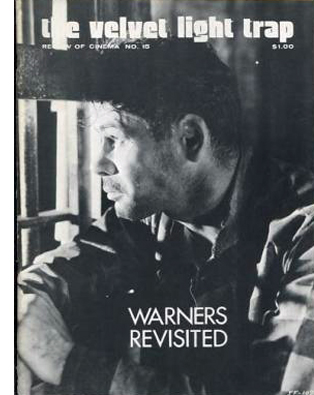 Just as important, American distributors like New Yorker and Audio-Brandon were releasing new European and Latin American titles as well as old works from Asia. In those pre-video days, 16mm prints were our best chance to catch up, not just through classroom showings but through the twenty-plus campus film societies. (There were Sam Fuller double features, but also Godard retrospectives and political documentaries.) And we had The Velvet Light Trap, which published zesty in-depth studies of genres, studios, and auteurs. The campus was movie-mad.
Just as important, American distributors like New Yorker and Audio-Brandon were releasing new European and Latin American titles as well as old works from Asia. In those pre-video days, 16mm prints were our best chance to catch up, not just through classroom showings but through the twenty-plus campus film societies. (There were Sam Fuller double features, but also Godard retrospectives and political documentaries.) And we had The Velvet Light Trap, which published zesty in-depth studies of genres, studios, and auteurs. The campus was movie-mad.
In my seminar on “Classical Hollywood Cinema and Modernist Alternatives,” we analyzed random titles from the Warners and RKO archives alongside Ordet, Equinox Flower, Four Nights of a Dreamer, and Chronicle of Anna Magdalena Bach. The Student Union screened Play Time in 35 across a whole weekend so my theory class could write essays on it. We brought touring Japanese, French, and Italian film packages to campus.
His Girl Friday, Meet Me in St. Louis, Possessed, Naniwa Elegy, Genroku Chushingura, Tom Tom the Piper’s Son, Death by Hanging, The Man Who Left His Will on Film, The Red and the White, and many other films became touchstones for us. In the midst of all this, senior colleague Tino Balio helped us see how to tie aesthetic analysis to the protocols of national film industries and similar institutions. He became a good friend and ally in many skirmishes, as did Jeannie Thomas Allen, with her work on women and media.
For Kristin and me, the years 1973-1980 crystallized research programs we never left behind. In these years I wrote my Dreyer book, Kristin did her dissertation on Ivan the Terrible, and we published Film Art: An Introduction. With Janet Staiger we began work on what became The Classical Hollywood Cinema. Meanwhile, our students were writing articles for journals and showing up en masse at conferences, a good-natured mafia.
Edward plunged into this and never looked back. He made an offbeat, poetic narrative film (which I hope his family can locate). He ran scenes to and fro on our Steenbecks and analytical projectors, checking match cuts and camera movements. He and Kristin drove down to Chicago for back-to-back screenings of Lancelot du Lac. He began writing on film color, a focus of his research for the next forty years. Above all, we were bound together by Ozu.
Tokyo Story was circulating in 16mm after its smashing New York revival in 1972, and Audio-Brandon and New Yorker acquired several more Ozu titles, early and late. That began our love, or rather mania, for this director. We three watched those prints over and over, eventually writing two essays for Screen in summer of 1976. Edward hoped for a long time to write his doctoral dissertation on An Autumn Afternoon, planning to devote an entire chapter to the woman in the red sweater who passes through scene after scene.
I still want to read that.
Ozu was never far from our thoughts. When Edward finished his dissertation, he gave me a framed still from Equinox Flower. It surmounts this entry. I learned so much from our conversations that I dedicated my Ozu book to him, with a Japanese inscription that means “the pupil who teaches the teacher.” As soon as the book went online, he wrote to tell me of Net problems.
I downloaded the Ozu book. Now, how do I get the color photos and the new crisp b&w’s? Must they be downloaded individually, one at a time? I want them in the book. I want them.
Thanks to his persistent pressure, the University of Michigan created a smoother download.
One constant point of discussion in the 70s was Ozu’s red teakettle in Equinox Flower. When in 2011 Kaurismaki noted it, I sent the link to Edward. He replied:
The red teakettle was a killer for sure. I never really leave the 70s and Vilas Hall… Late nights. 16mm stop motion. I also very much appreciated your blog entry on the four looks at Ozu. Shouldn’t you at some point do a streaming video for your blog?
Sometimes Ozu was merely evoked, not mentioned. One email had this attachment.
Edward knew I would immediately think of a shot from Dragnet Girl and two from Early Summer.
My last email from Edward in May includes this:
Ozu… A year ago I looked at all six of his color films. The color designs are distinctive and sophisticated, but perhaps too complicated to write about. . . .
If he were still with us, I bet he’d try.
Edward’s vitae is available here.
We’re grateful to all those who have shared Edward’s company with us over the years. Vance Kepley helpfully corrected my memory of the 1970s. Thanks especially to Roberta Kimmel and Evan Branigan, who sent us bulletins.
P.S. 9 July 2019: Thanks to Chuck Wolfe, Edward’s tireless colleague at UCSB, for correcting my initial claim about his undergraduate major.
P.S. 12 July 2019: The Film and Media Studies Department at UCSB has posted its tribute to Edward.
Edward Branigan, 1945-2019.












